#Edward looks fabulous and in his element
Explore tagged Tumblr posts
Text
I wish everyone luck! 😁 since im not an artist.... 🥲💔
🎨 ~Make Your Mark~ 🎨

Welcome to the official The Ideal Iplier Community Art Event!
To mark the special occasion of the game being 50% complete, as well just as a special thank you to all the fans that has followed and supported the game since 2018, I’m hosting a community art event!
This art event has been planned for a long long time, the plan was to always do it after 80% completion of Dr. Iplier’s second date. School and work however pushed production back heavily in the last year. But now with full certainty Dr. Iplier, Tim and Sam are now ready to see your artworks!
The art event is for everyone! You don’t even have to be super talented in art to enter, Dr. Iplier’s second date is all about embracing your inner creativity. Having full confidence and passion in what you create is something he always strives for. Not only that but he loves to admire the hard work of others knowing they put as much effort into it as well, for in every art piece you are giving a part of you to it 💚
His second date features in itself an art event which is why I thought it was perfect to do this for the game’s followers. The art event is “superhero” themed, as in heroes, villains, antiheroes. But even so in the game it can be taken literal (Silver Shepard, JackieboyMan) or symbolic (Darkiplier, Actor Mark, Wilford, etc.). So your goal is to come up with a theme using the umbrella term of the superhero world, and the egos!
What we’re looking for is most notably Markiplier Egos because this is a Markiplier Ego game, but I will allow egos such as Jacksepticeye Egos and Ethan Egos (Mad Mike for example since he was in the first reveal with A Date With Markiplier series where Dark was in) as well if they are closely correlated to Mark’s world in the egoverse.
The art can be anything you think of! Grab your favorite ego and let the brush flow!
But that’s not all! There will also be a competition hosted in the midst of all this too!
Regardless, your art piece will go in the game, that’s right, it’s a definite automatic in while the event takes hold. But the top three winners will also receive a special cameo of themselves/their sonas in the game!
The winners of the contest will also receive the full collection of Mark Ego V-Day pins and charms in a little gift basket sent to them! This is open to international people as well! No cost necessary, just the comfortability of providing your shipping address if you win 🥰
The deadline to submit your artworks for the competition is Oct 27th! This is Dr. Iplier’s birthday so it made sense to me for us to celebrate this way :) Competition winners will be announced at 11:59 PST that night as well! The deadline to include your art in game for the event is Nov 9th! Exactly one month from now 😊 Please come prepared with refs of yourself/your sona if you are one of the winners :3 Make sure you have your DMs open as well so I can contact you about further information.
That is all! Thank you so so very much for all these wonderful years so far. The game still has a long way to go from being complete, but we are making headway towards the finish line 💙
If anyone has any further questions, do not hesitate to comment under this post or dm/@ us directly 😊
Good luck to everyone! And most importantly have FUN!
#markiplier#theidealiplier#markiplierfangame#markiplieregos#markiplieregodatingsim#darkiplier#dr. iplier#googleplier#bingiplier#bimtrimmer#wilford warfstache#jacksepticeye#jacksepticegos#Edward looks fabulous and in his element#fucking love him
129 notes
·
View notes
Text

bringing this over from twitter because nobody is reading twitter anymore lmfao and i figure the long version is more likely to be interesting to people here
(the OP is responding to some film account's description of something in an upcoming Avatar movie, not that it really matters but that's the context in case anyone was curious)
putting this under a cut because, as is apparently customary for me, the long version is like. really long.
the elemental theming for different nations in FF4 is not very strong and we do not see much of Damcyan anyway but i do think it has a pretty interesting angle on what a "fire kingdom" looks like
the crystals mostly serve as a metaphor for stewardship of the land and the people on it. the earth crystal in Troia is probably the most on the nose about it but that's kind of my read on the whole deal. various fantasy settings, particularly video games, have had different variations of what a "fire landscape" looks like, and a lot of times its inhospitable. (FF5 always makes me laugh here because Karnak, the fire crystal city in that game, just has literal open flames straight up raging in the streets, presumably all the time. the people there are actually distressed when the fires go out. but i digress) Damcyan is a desert, which is kind of a harsh environment comparatively but both naturally occurring and perfectly habitable, a place one ought to care for and not just a big empty wasteland.
Besides being situated in the middle of a hot, bright environment there's a vague aesthetic connection to fire. edward dresses in bright red and gold, with anna in a yellow dress and sometimes bright red hair. the DS version puts sunbursts on the castle walls and a lit candle on their flag, and maybe this is just me overthinking it (this whole thing is tbh) but the SFC version of Damcyan castle features these weird clusters of extremely tall towers that almost resemble smoke stacks or something. at any rate Damcyan is at least slightly more clearly "fire themed" than Fabul is "air themed", for example.
the elemental connection is again mainly metaphorical, in the associations people have made with the classical elements. water is knowledge, air is discipline, earth is abundance, and so on, which means Damcyan is indeed supposed to have the figurative qualities of fire
which are...
well, again we don't see much of Damcyan. in-game, their prince is a bard (and in the DS version they also have a lyre on their flag). they have soldiers but are clearly not intended to be read as militaristic in any way. the castle has a dungeon, which is full of treasure chests largely containing hats. it has the first healing pots you'll come across in the game. it's the only country on the surface besides Baron that seems to have anything approaching modern tech, and its a civilian vehicle that helps you get across the desert. the area's signature boss monster produces a healing item and is supposed to be docile despite its terrifying appearance.
Edward himself is primarily known for his beautiful voice and is a healer, mechanically speaking. the first thing we learn about him is that he eloped with his lover against her father's wishes, and while the game on its own doesn't really give any context for his apparent habit of wandering around in disguise, it's very easy to read his behavior as impulsive. he's extremely emotional, to the extent that it actually bleeds into the battle system. so he's "fiery", in a sense, but in a way that's essentially the opposite of aggressive
the primary quality of fire here, i think, is compassion -- warmth and light, music and love and healing. it's a harsh world out there, but here in the firelight even the monsters are tame
plus, a little bit of "hey, can't you use fire to do metal smithing? what about a combustion engine? wouldn't that make you like, fabulously wealthy?" thrown in there for spice i guess
(actually, if you want to combine poet-kings, the vague tech-y overtones of the place -- including Edward functioning as a sort of proto-Chemist -- and the guidebook stuff about Damcyan having gotten extremely rich off trading and idk Rubicante, you could probably make a good argument that "fire" also serves as a general emblem for "civilization," but that's neither here nor there and this post is already long as fuck)
#edward chris von muir#ffiv#overthinking it#meta#if you followed me this is ultimately what you signed up for im sorry#had some comments in here about edward's wandering around re: the reasons given for it in the light novel but#i think that's for later
4 notes
·
View notes
Photo

#9 – GLASS ONION: A Knives Out Mystery | Netflix | Writer/Director Rian Johnson - As a filmmaker how coveted would it be to discover you’ve created a franchise? I suppose it would depend on how much you love the world you’ve built. Well, Rian Johnson is more than fond of his knives out mystery verse and lead character Benoit Blanc (Daniel Craig) and if Glass Onion does half as well as 2019’s Knives Out (PhilaFCC Best Picture winner) then they’re both happy to keep the franchise going.When it comes to movies and COVID what I’ve mainly seen so far is either the movie is steeped in it or ignores it all together. Johnson decided to address it as the elephant in the room for a beat at the beginning and then cleverly shoots the elephant and rids the rest of the movie of this actuality. We are introduced to the cast or rather soon to be suspects: Birdie Jay (Kate Hudson) a vacuous, self-centered music legend, with a fabulous wardrobe.
Her assistant Peg (Jessica Henwick), has the difficult job of keeping Birdie from being cancelled again on Twitter. Kathryn Hahn, whose career is super hot these days, plays Claire, a democratic politician. Duke Cody (Dave Bautista) is a Joe Rogan type influencer. Cody’s girlfriend Whiskey (Madelyn Cline) seems to be just a pretty face who looks hot in a bikini, but she’s much smarter than she looks (this is not a clue). Lionel (Leslie Odom, Jr) is a brilliant scientist. Andie Brand is a corporate CEO (Janelle Monáe) who steals the movie, she’s so watchable. And all of them revolve around Miles Bron (Edward Norton) a compilation of Elon Musk, Jeff Bezos and any other billionaire with too much excess and no sense of reality.We’re introduced to them individually in their own worlds, but soon we have them all on Bron’s island for a little reunion, as all these characters know one another from their early days before their careers took off.
I won’t tell you why or how Benoit Blanc is on the island, but I do like that we get to see a bit of his home life too before going.For me, Rian Johnson has done it again! I enjoyed it almost as much as Knives Out, although it’s impossible to recapture the element of surprise I felt back then, realizing Johnson had modernized the Whodunit to so much good effect. For Glass Onion my expectations were already set. Knives Out was also a darker comedy; the mood and location for this one is much lighter with less layers, which is ironic that it doesn’t have as much to peel. But in terms of staging, pacing, engagement it’s right up there with the original.Got a chance to interview Rian Johnson during PFF31 in a roundtable with PFCC Members – LISTEN HERE
0 notes
Note
Got this little hc where Gray is, like, the most financially stable of the team. We never hear him groan about money, not once in the series, while so many others do. Gray probably had a really nice flat or something that he always pays the rent for on time. I also hc that he's got a great rep for being good at damage control on solo jobs, but add Natsu or Erza into the equation and all of Gray's composure and brain cells just temporarily evacuate. Like, the guy actually gets very little complaints from his clients aside from his stripping habit.
I'm curious if u would agree with my hc that Gray is actually pretty good at sketching, architecture, and has better-than-average understanding of physics and engineering. The guy is pretty pragmatic and down-to-earth for a Fairy Tail mage, and his creations are more simple but efficient and effective than elaborate like Lyon's. I think he he practices and enriches his magic by studying architecture, physics, and engineering to better know how to utilize it. The sketching he does is just to practice his imagination and design potential new creations.
(Cana and Loke once read through his sketchbook. After seeing the well-thought-out schematics of a massive chainsaw and an attack that looks scarily similar to Erza's blumenblatt, they carefully put the sketchbook down.)
I really love how Gray puts the impression in everyone he’s stable and normal but once you get to know him he’s anything but.
Design-wise as anime tropes go, Gray’s the dull colour on the wheel (dark blue/black) to contrast the vibrant yellows and reds from the others, so there’s balance in the dynamics and designs in the main crew. Typically these characters are also the assigned Tsukkomi, because their visual normality implies they’re the voice of reason. And usually, they’re somehow the most unhinged of the group in one specific, very eccentric way (which for Gray would be the stripping habit. I love characters like that in older shounen anime, they’re usually my favourite of the group.
So. Like. Yes. Gray as a genuinely competent, financially stable, and generally responsible person in his daily life that just gets wrung down once Natsu gets within fifty feet of him. Fabulous.
ALSO. That headcanon for Gray being good at sketching? It is perfect. I just makes so much damn sense I am miffed I didn’t think of it earlier. It makes so much sense for literally all of his ice creations, actually match up with him specializing in static creation by adding more depth to that fact, and like. This sets him apart from Gajeel despite them both being ‘make weapons out of their element to fight’ wizards. And it reflects how practical he is compared to Laki’s chaotic art, for example. I like it so much omg.
The idea that his ideas can range from practical to just objectively horrifying is just. A mix between a chuuni’s dream come true and Edward Elric. Please.
85 notes
·
View notes
Text
All Quiet on the Western Front (2022, dir. Edward Berger) - review by Rookie-Critic
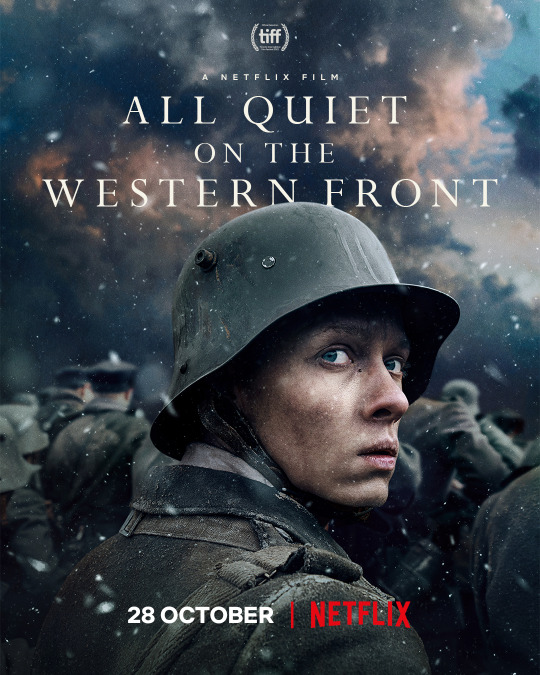
Showing the atrocities of war is always a tightrope walk. You want to show how brutal it is, you want to show people that this thing, this behemoth that has overtaken the world more times than can ever be counted, is horrid and should be avoided if at all possible, but you don't want to desensitize, you don't want to present it so fast, so hard, so unprofoundly nihilistic that it loses its meaning. You don't want to numb people to the pain or push your messaging past its limit, to make the term "war is hell" into a parody of itself. While there were a lot of things I really liked about Netflix and Edward Berger's remake of All Quiet on the Western Front, I feel like this is its biggest issue.
It revels in its "more is more" approach to showing how horrible the Western front lines of the first World War were and it causes the immersion to break and it cheapens the film's very real and very potent anti-war sentiment. The anti-war film is nothing new, we've seen this song dance a million times before, made extremely evident by the fact that this is a remake of the world's first significant anti-war film by the same name, which came out in 1930, 94 years prior to its successor. We've had close to a century of powerful, magnetic, devastating anti-war stories: from Chaplin's The Great Dictator to Kubrick's Paths of Glory AND Full Metal Jacket AND Dr. Strangelove to The Deer Hunter to Apocalypse Now to Das Boot, Platoon, Grave of the Fireflies, 1917, Jojo Rabbit, and on, and on, and on. We get the song, we get the dance, it is a very important message, but we no longer need it spoon-fed to us. The unfortunate thing about the new Western Front is that its images and iconography are intensely powerful and very profound, they get there and they do it fabulously, but then they don't stop. Every scene has an element to it that feels superfluous, that feels like they're bashing your head against the wall that says "war is hell" and screaming at you "DON'T YOU GET IT?!" The answer is, yes, I do, I got it, and I would have without a lot of the, for lack of a better term, extra that's here.
To lay out my point with an example from the film, and don't worry it's not really going to spoil anything (although if you really don't want to know then you should just skip ahead to the next paragraph), but there's a scene in the film involving the general who is in charge of our protagonist's regiment. This immediately follows what is possibly the most intense and brutal sequence in the entire film (which, again, outside of a handful of superfluous elements, is really quite a powerful sequence), and the film juxtaposes all the horror we just witnessed with this general, sitting safely in a very large dining room, eating a feast with a direct subordinate. We get extreme closes ups of everything on the table: olives, fresh bread, a whole leg of lamb, wine, which he drinks a few sips of then tosses the rest on the floor and asks for more. He does this thing with the wine several times throughout the scene. He asks his subordinate about his life back home and what he will return to once the war is over and the subordinate tells him about his family's riding saddle manufacturing/selling business. The subordinate asks the same question to the general and the general goes on a tangent about how he is a soldier who was born in the wrong time because, before this current war, his whole life had been peaceful. He says "what is a soldier without war?" Then tosses what looks like more than half of the meat on his plate to the dog sitting on the floor. This scene would be so infuriatingly impactful and meaningful if the film didn't insist on shoving the message down our throats. I didn't need close ups of the food, I didn't need the spectacle of watching him deliberately waste food and drink, I didn't need this man's hypocrisy slammed into my eyeballs a thousand times over. The atrocious nature of the scenario lies in the scenario itself! Just cut to this horrible man eating his clearly excessive meal in safe quarters after we just watched a lot of men that he is responsible for get brutally mowed down for nothing; no close-ups of the food, no excessive food waste, just the scene itself. Let him talk about how much of a soldier he is. Let this moment be peaceful, that in and of itself would be powerful enough. We, the audience, will get there. We will understand what the film is getting at, it's not that difficult to comprehend, but this is the kind of thing that permeates the entire film.
Here's the thing, I'm still going to give All Quiet on the Western Front a good score, because the truth is I still really liked it. The film has an excellent core. The acting, for the most part, is amazing. The cinematography is unbelievable and the production value is off the charts. Even the story itself, while not really new, is engaging and has a very strong foundation. I just wish it had trusted its audience more and didn't feel the need to just keep adding to itself, to keep piling on more and more until it's just hard to stay engaged. I'm sure this will win a fair amount of Oscars, and it's not entirely undeserving of them, but I don't think it entirely deserves the near-unanimous praise its been getting, because there are a fair amount of problems with it.
Score: 7/10
Currently streaming on Netflix.
#All Quiet on the Western Front#All Quiet on the Western Front 2022#Edward Berger#Felix Kammerer#Albrecht Schuch#Aaron Hilmer#Moritz Klaus#Adrian Grünewald#Edin Hasanovic#Daniel Brühl#Thibault de Montalembert#Devid Striesow#Andreas Döhler#Sebastian Hülk#film review#movie review#2022 films
4 notes
·
View notes
Text
“Entertainment held an important place at the English royal court under Eleanor and Henry II, in contrast to Louis VII’s court, known for its sobriety and solemnity. Eleanor’s second husband invited jongleurs and performers of all sorts to his court, doubtless encouraged by her. English moralists, much like critics of the court of Eleanor’s grandfather at Poitiers, condemned the Plantagenet court for immorality, complaining of actors, mimes, and dancers who fostered debauched conduct among the courtiers.
Just as with other princes new to power, Henry Plantagenet, after winning the English Crown, attracted to his court singers and writers to compose poems and songs, glorifying him and his lineage. Among the crowd of courtiers were serious writers in Latin and in the Anglo-Norman vernacular, and during Eleanor’s years as English queen, troubadour lyric poetry, courtly love, and courtly romances spread to the Anglo-Norman world. A former poet turned monk at Eleanor and Henry’s court noted ruefully, “When I frequented the court with the courtiers, I made sirventes, chansons, rimes and saluts [types of secular lyrics], among the lovers and their mistresses.”
Yet a cause and effect relationship between Eleanor’s arrival in England and the advent of courtly literature there is dubious. Certainly a uniquely productive literary culture flourished at the royal court under Eleanor and Henry, and learned men flocked there, as evidenced by an extraordinary flowering of literary works in several genres. The queen, of course, had grown up at a court where literature and learning were valued, as had Henry. A contemporary described his father Geoffrey le Bel as “most highly lettered, commanding eloquence which set him far above both clerics and laymen, replete with all good manners.” Even before Henry became king, writers were dedicating works to him.
It is unlikely that the young duke of Normandy commissioned their works, however; they were dedicated to him in anticipation of his patronage once he took the English throne. Certainly, the court of Eleanor and Henry II earned a reputation as a beacon for courtly writers. As king of England, Henry was eager to encourage authors writing on varied subjects, no doubt expecting their works to reflect favorably on him as a powerful monarch. He sponsored both Latin language and Anglo-Norman vernacular works, among them historical works written in England and Normandy and also in Anjou that would give an illustrious past to both his Plantagenet predecessors as counts of Anjou and his Norman ancestors who had captured England’s royal Crown.
He wished during his quarrel with his archbishop of Canterbury to shore up the English monarchy’s sacred character with writings pointing up the sanctity of his predecessors. In his competition with the Capetian kings he needed to claim as forebear some heroic figure equaling their prestigious predecessor Charlemagne, and King Arthur or Edward the Confessor could potentially fulfill that need. Both of Henry I’s wives had been known as patrons of literature, and Henry II, who modeled himself on his grandfather, associated his queen with him in extending patronage to writers, even if no explicit evidence for their commissions of works survives.
Yet dedications or eulogies inserted by authors into their works afford indirect evidence that they viewed their monarch or his queen as prospective if not actual sources of patronage. Not all clerics wrote in search of material gain, however; some were impelled to write in the hope of instructing and correcting their prince, and others simply sought to show themselves loyal subjects through passages praising their ruler. There is no evidence that the nun of Barking who translated a Latin life of Edward the Confessor into Anglo-Norman had a commission from Henry II or his queen, although she would have known of the king’s support for the Confessor’s canonization. Perhaps she hoped to win their favor for her convent through her work. She inserted into her translation a passage calling on God’s protection for the king, the queen, and their lineage, and their divine sustenance in sanctity, peace, joy, and plenty.
For clerical authors at court who often doubled as royal clerks, it is impossible to separate patronage of their literary activity from payment for their secretarial services. Their reward from Eleanor or Henry often came in indirect forms, as presentations to churches or to cathedral prebends, whether in return for activities as royal scribes or as authors. Best known are clerics writing in Latin at the court of Eleanor and Henry, such as Gerald of Wales, Peter of Blois, or Roger of Howden; but Wace, a writer of histories in Anglo-Norman, was awarded by the king with a prebend at Bayeux Cathedral in the 1160s.
Eleanor had grown up at the Poitevin court that gave birth to troubadour poetry, and she certainly heard, read, and encouraged courtly literature. The royal court of Henry II attracted singers of songs, viol players, pipers, and other musicians; and among these entertainers were poets and composers. No doubt scores of songs were commissioned as propaganda in praise of the monarch and his queen or to commemorate special events such as celebrations of victories or the births and marriages of royal offspring, and once sung were soon forgotten.
Occasionally a pipe roll entry records payments to a storyteller (fabulator) or a harpist (citharidus). Although no documents survive to register Eleanor’s own commissions of literary works, handsome sums were regularly handed over to her from the royal treasury that could be used for distributing patronage to writers without leaving any trace in the exchequer accounts. The absence of documents recording Eleanor’s payments to writers does not preclude her showing favor to them with cash from her personal treasury or with gifts of precious objects.
Royal reward to writers, like favors to other courtiers, could take the form of gifts of robes or other clothing, gold cups, or even horses and mules. A Catalan troubadour writing a decade or more after Henry II’s death wrote of hearing how “Sir Henry, a king of England, gave horses and mules as gifts.” A week spent entertaining a generous patron could win a singer or poet robes worth more than most peasants earned in a year. Lacking other documentation, however, the poems themselves must bear witness that their authors expected to win the English queen’s favor through their writings.
…During Eleanor’s early years as English queen, she seems to have shared her husband’s taste for histories, especially those written in the Anglo-Norman vernacular. Henry II commissioned writers experienced at composing romances who could make historical writings available to a courtly audience not well educated in Latin. In about 1155 a royal clerk Wace won a commission to write the Roman de Brut, an Anglo-Norman adaptation of Geoffrey of Monmouth’s Latin history. Layamon, a priest who translated the Brut into English in the first decades of the thirteenth century, claims that Wace had dedicated it to Queen Eleanor and that he wrote of her, “Generous is Eleanor, gracious and wise.”
Possibly Layamon had seen a now lost presentation copy that contained a dedication to the queen. While his statement is no direct proof for Eleanor’s patronage, at least it indicates that she was thought to be a queen interested in literature and capable of offering favors to authors attracting her attention. Hardly accurate history, the Roman de Brut presents the story of the early Britons from the arrival of Brutus, a refugee from the Trojan War, to the Saxon invasions as if a translation of an ancient book in Breton (or Welsh). Although Wace incorporated oral traditions transmitted in minstrels’ songs, Geoffrey of Monmouth’s History of the Kings of Britain was his chief source.
His vernacular reworking of legends of the ancient Britons, adding courtly elements, would play a pivotal part in medieval literature as the source for the “matter of Britain,” for it proved appealing to composers of later twelfth-century romances centering on King Arthur, Guinevere, and the knights of the Round Table. As a result, the legendary Arthur, his queen, and his knights became as much a part of history for twelfth-century readers as biblical personages or as heroes from the Latin classics, and Wace may have modeled his depiction of Arthur’s queen on Eleanor.
Perhaps courtiers hearing or reading these romances were tempted to see Henry and Eleanor in the portraits of Arthur and Guinevere. If modern readers can see parallels between fictional characters and historical personalities in twelfth-century romances, then Eleanor and Henry’s contemporaries could have seen them even more clearly. Medieval readers expected to uncover more than one level of meaning during their reading, and they were attuned to the allegorical nature of poetry.
Henry II, though materially more powerful than his rival Louis VII, felt himself “ideologically inferior” because of the Capetian king’s prestigious ancestry, traced back to Charlemagne. Arthurian material is sometimes said to have provided useful propaganda for Henry in his rivalry with Louis and later with his son Philip II, offering King Arthur as a prestigious royal predecessor from an even earlier time than the Capetians’ Frankish predecessors. Yet Henry made only fitful and desultory attempts at constructing an Arthurian ideology to counteract the Capetians’ use of Charlemagne.
Seeking ideological advantage from Arthurian material was not without risks, for King Arthur and Arthurian legends could serve better the purposes of rebellious English nobles, who found in Arthur and his faithful men gathered at the Round Table an idealized view of earlier kingship. Arthur was closely identified with the inhabitants of the Celtic fringes, people looked on by the English as savages, and Arthurian tales had an especially subversive effect on the Welsh and the Bretons. Henry II commissioned another book from Wace, the Roman de Rou, a history praising his Norman ducal ancestors from Rollo (or Rou), the Viking invader of Normandy, down to his grandfather Henry I; and the clerk prepared himself for the task by reading early Norman chronicles, listening to epic poetry, and even examining charters in Norman churches.
…Eleanor may have had some connection with another scientific work, a medical text in Latin brought from Sicily to England by Robert Cricklade, prior of Saint Fridewide’s, Oxford (d. c.1171). He was the compiler of a scientific text, an abridgement of Pliny’s natural history, that he had dedicated first to King Henry I, then later to Henry II. Like a number of English scholars, Robert traveled in Italy, going to Rome and Sicily in 1156 and returning in 1158. While in Sicily, he was given a copy of the Gynaecia Cleopatrae, originating in Constantinople, to take back to England to the queen.
Eleanor would have learned of the reputation of Greek medical learning while in Constantinople during the Second Crusade. It is plausible that the English queen, anxious after the early death of her son William, had asked the prior to bring from Sicily medical books on childbirth, care of children, and female disorders. At the time of Robert’s departure, Eleanor was left with only one boy, Young Henry. Given her record of bearing only daughters in her first marriage, she may have had dynastic concerns about producing more sons. If so, her fears proved unrealistic, for she quickly produced two more sons in 1157 and 1158.”
- Ralph V. Turner, “ A Queen’s Work: Regent for an Absentee King, 1155–1168.” in Eleanor of Aquitaine: Queen of France, Queen of England
#eleanor of aquitaine#eleanor of aquitaine: queen of france queen of england#history#high middle ages#medieval literature#ralph v. turner#henry ii of england
36 notes
·
View notes
Text
The imagery of BBC ‘Dracula’: mythology, alchemy, literature. Part 5

Part 1.
Part 2.
Part 3.
Part 4.
Literature
The classic horror novel by Bram Stoker, which formed the basis of Dracula, has gone through many adaptations. The new BBC series is one of the closest to the text of this work.
To begin with, the entire first episode, with minor changes, almost literally repeats the description of the story of Jonathan Harker from his diary in the novel, and those details that look different in the film are changed so delicately and embedded in the narrative so gracefully that when watching it, you get a complete feeling of the exquisite classical setting.
But this feeling is deceiving. Like much of what Steven Moffat offers to his viewers, this story is a complex text, saturated with all sorts of meanings and literary references.
First of all, as I have already said, the film itself ‘lies’ on the material of the novel as a basic fabric. All its plot and psychological twists come from here, as much of the story, and – characters, which are recognizable even when their roles are changed. Further, as you move through the text, hidden ‘pockets’, motives, and whole plug-in plots are revealed in it.
The most obvious, of course, is the plot, parodying the novel by Agatha Christie Ten Little Niggers (And Then There Were None) about people gathered in a closed space from which it is impossible to get out, dying one after another.
What matters here is not so much what work is chosen for the parody as the way it is introduced into the text and creating a kind of crossover by the authors of the film. Absolutely in the spirit of fanfiction.
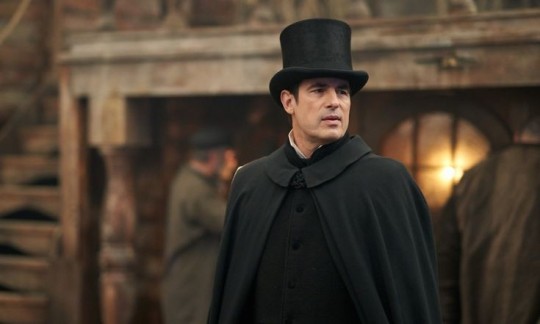
What if Count Dracula finds himself in a situation from Ten Little Niggers? How will he behave? What will the other people do? Will Count be revealed? And if he will, in what way this problem could be solved? In this sense, it seems to me that it is very important to pay attention to how the narrative structures from one genre (fanfiction) affect another (film) and how naturally these very structures invade today where it was difficult to imagine them thirty years ago (or they were forced then to ‘hide’ or disguise).
The teenage ‘vampire thrash’ that the story of Dracula and Lucy Westenra shows us is just as parody. Balancing on the verge of drama, comedy, erotic novel, this story consistently passes through all the stamps of films and books about bloodsuckers loved by young fans of the genre and turns them inside out.
Love watching a fragile and beautiful heroine meet a fatal man? Here the guy is for you, spectacularly appearing in red light in a nightclub. Do you like impudent girls who themselves throw into the arms of vampires and are not afraid of anything? Please, here's a date at the cemetery. Do you prefer romantic conversations and slow cuddling to a gentle neck? It's not difficult for us. And all this is lined with restrained, slightly melancholic, calm laughter of an adult, showing tricks to a child. With a final note that will show everything that is needed to the one who understands.
And finally, the most vivid, unexpected, and beautiful literary allusion, which gives the story an additional dimension and special meaning, is, of course, the finale. I didn't immediately notice the reference and realized exactly what it meant after the second or third viewing. Probably because it is too obvious.
Who first appears in your memory when you think of the great lovers in world literature? That's it. Only, unlike that one, this story does not seem sad.
But how elegantly done and played.
Romeo and Juliet were representatives of warring families, in fact, enemies that could not be together under any circumstances.
Who could be more antagonists than a vampire and a nun?
Romeo and Juliet fell in love with each other in spite of everything and against the will of their relatives, they strove for each other.
The entire episode on the ship is about how mutual attraction, interest, and love arise despite the circumstances, the wishes of the characters, and the frankly cruel behavior of one of them. And in response to Dracula's words that the kiss of a vampire is an opiate, the quote requested by, ‘You kiss by the book.’*
For violating the order of the Duke, Romeo was expelled but returned after learning that Juliet had died. Finding himself in the crypt in front of her (as he thought) dead body, he was poisoned.
One of the main plot conflicts and drivers of the third episode – is there Agatha here or not? Is she alive or dead? And if there is not Agatha, can she be returned?
And when Juliet, according to the plan of the priest, who undertook to help the lovers, woke up and saw the lifeless Romeo next to her, she stabbed herself with Romeo's dagger.
In the final episode, Dracula dies from the poison in Zoe's blood and Agatha – from the bite of his fangs.
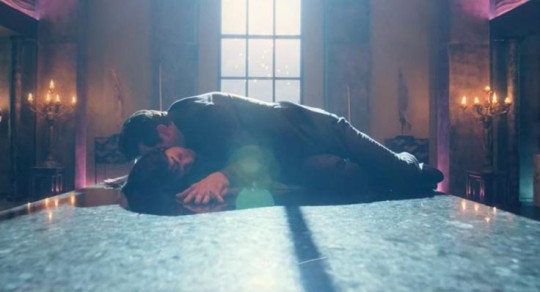
Not enough for you?
Romeo and Juliet, Act II Scene II
But, soft! what light through yonder window breaks?
It is the east, and Juliet is the sun.
Conclusion
All the mythological, alchemical, and literary images we have considered here, in one way or another, ultimately work for the story. Not only to make it sound brighter and more original in a new performance but also to understand it. Because there is no Dracula without Shakespeare's heroes, without Agatha Christie's half-fabulous, hermetic detectives, without tension between the ‘vampire’ canon of the nineteenth century and the same canon one hundred and fifty years later, changed almost beyond recognition and made a new round in the story of Edward Cullen. And the better you understand them, the more voluminous and profound the story being told becomes.
So much the better you can see how far art has gone and how it today reflects what it feared yesterday and what it only briefly mentioned.
You see, after all, in Stoker's novel, Dracula is not so much a man or even a monster, but a certain mysterious incomprehensible element, chaos embodied, the personification of natural force, which is opposed by human reason and courage. It is no coincidence that the novel is constructed as a collection of written evidence – documents, newspaper clippings, letters, and diaries. The ‘screen’ of words, created by the author, allows the reader to distance himself from what is happening to the extent that he can perceive it calmly, without being captured by the emotions that are caused by the incomprehensible and supernatural. This is a very wise decision on Stoker's part, especially in the nineteenth century, when such stories were new to people and served in part as a way to ‘tame’ and make familiar their own fears.
Therefore, this novel probably gave rise to a whole genre. From this seed, almost all Western European horror literature grew. And the way the new Dracula is shown in the BBC film shows how long it has come.
From overwhelming panic horror through reckless falling in love (which psychologically can be considered an inverted fear – something like Stockholm syndrome) to the search for humanity. And love.
Because the stories of monsters and vampires are always about us. About how we look at the world and at ourselves. What we love in ourselves and what we hate. What are we ready to run headlong for, and what we turn away from. And what makes us who we are.
And if Sherlock Holmes helps us to understand how high we are ready to fly, then Dracula – how much courage we have to see who lives in the depths.
* W. Shakespeare Romeo and Juliet, Act I Scene V.
10 notes
·
View notes
Text
Staff Picks: Our Favorite Art History Jigsaw Puzzles
As fans of looking closely and spending quality time with images, it’s no wonder that the staff of an art history website loves doing jigsaw puzzles! Not only are puzzles fabulous tools for sharpening your visual acuity skills, but they also make a wonderful way to relax indoors on days when it’s too hot or too cold to be outside.
Here are some of the Sartle team’s favorite jigsaw puzzles for art history lovers that can keep you occupied all year round.
We hope you find these products as delightful as we do. Just an FYI: Some of the links below are affiliate links, meaning that at no additional cost to you, by clicking through and making a purchase, you will also be contributing to the growth of Sartle.
1. Children’s Games by Pieter Bruegel 2000-Piece Jigsaw Puzzle
Few works of art reward close looking as much as Pieter Brueghel the Elder's paintings. With his tiny (and often humorous) details, there’s so much to enjoy in Bruegel’s worlds brimming with figures and activity. In this jigsaw featuring his 1560 painting Children’s Games, you’ll discover all those details anew! And at 2000 pieces, you’ll be kept busy for a looong time. - Jeannette
Find it on amazon here.
2. I Saw the Figure 5 in Gold by Charles Demuth 1000-Piece Jigsaw Puzzle
I may just have a big soft spot in my heart for Charles Demuth's precisionist paintings, but this 1000-piece puzzle featuring I Saw the Figure 5 in Gold from the Met is just stunning! With those gorgeous intersecting planes of pure color, it provides just the right amount of challenge while still being interesting. - Jeannette
Find it at the Met store here.
3. Viva la Vida Frida Kahlo 1000-piece Jigsaw Puzzle
This adorable 1000-piece Frida Kahlo-themed puzzle comes in the dreamiest shades of pink and purple, but what I like most about it is all the little details about her life in the vignettes in the background. There are references to everything from her clothes and medical corsets, to her pets and travels, and specific paintings featuring her and Diego. The fact that this puzzle is made by a woman-owned business is just the icing on the cake! - Jeannette
Find it on amazon here.
4. Nighthawks by Edward Hopper 1000-Piece Jigsaw Puzzle
Most people know the image of Edward Hopper's Nighthawks, but putting it back together via this high-quality puzzle truly allows you to appreciate the subtle details of this atmospheric painting, like faint gradations of colors and brushstrokes, which might go unnoticed on a laptop screen. Difficulty-wise, there's enough recognizable figures to guide the puzzler, but enough flat swathes with fewer elements to keep it challenging. - Angelica
Find it on amazon here.
5. Bridge and Waterlilies by Monet 1000-piece Jigsaw Puzzle
I love the concept of an Impressionist puzzle, like this one of Claude Monet's Bridge over a Pond of Water Lilies from the Met. The puzzle format is perfect for Monet’s Impressionist painting technique, where a melange of smaller, separate brushstrokes and colors come together as a whole to form an idyllic scene. And what better daydream for when you're stuck inside than strolling past the water lilies in his famous garden at Giverny? - Angelica
Find it at the Met store here.
6. Convergence by Jackson Pollock 1000-piece Jigsaw Puzzle
When it comes to puzzles, I'm a bit of a glutton for punishment...but this whopper of a Jackson Pollock drip painting is positively daunting. Pollock's signature style of splashing overlapping lines of paint to create a tangled web means that you won't be able to strategize by color-coding the pieces. It's got a 5-star rating from over 100 other puzzle masochists, so join their ranks if you dare! - Angelica
Find it on amazon here.
7. Starry Night Petals 500-Piece Puzzle
Call me basic, but I love plants and Vincent van Gogh’s Starry Night, and this puzzle makes my heart happy by combining both of those things. This particular puzzle makes assembling simple for the whole family as it’s easy to sort pieces by color and plant type. And in my family, the fewer reasons for arguing the better! - Lauren
Find it on amazon here.
8. The Sistine Chapel Ceiling by Michelangelo 1000-Piece Jigsaw Puzzle
In early 2020, my husband and I were planning a trip to Italy with a solid two days to explore Vatican City when the pandemic hit. The Sistine Chapel is so big and this puzzle is, respectively, so small, that you’re going to need a magnifying glass to see the necessary details to put it together. Though we will likely go to Italy soon (fingers crossed!), inspecting tiny pieces of Michelangelo’s masterpiece will have to do for now. - Lauren
Find it on amazon here.
9. The Great Wave by Katsushika Hokusai 500-piece Jigsaw Puzzle
Aside from the Mona Lisa, I would say that Hokusai’s Under the Great Wave at Kanagawa is one of the most recognizable pieces of art of all time. It has been copied and parodied the world over appearing on mouse pads and book bags everywhere. The little fingers of the wave will be a pain to sort through, but oh so satisfying. - Lauren
Find it at the Met store here.
10. The Eclipse by Alma Thomas 1000-Piece Jigsaw Puzzle
As a lover of all things approved by the Obamas, Alma Thomas was quickly put on my radar when they added her work, Resurrection, to the White House Collection in 2015. Her colorful, abstract paintings were made for lovers of difficult puzzles. The color-blocked circles might make this type of puzzle seem easy, but with little shading, that orange piece could go anywhere. This puzzle will give you days worth of frustration, if you’re into that. - Lauren
Find it on amazon here.
Wishing you many moments of the pure satisfaction and inner ~piece~ only a puzzle can provide.
By: Jeannette Sturman
#fun stuff#jigsaw puzzles#shopping#michelangelo#alma woodsey thomas#frida kahlo#charles demuth#Pieter Bruegel the Elder#nighthawks#edward hopper#claude monet#katsushika hokusai#starry night#vincent van gogh#sistine chapel#gift ideas#relaxation
1 note
·
View note
Text
Ranking : Marvel Cinematic Universe - The Infinity Saga (2008 - 2019)

Outside of the Star Wars or James Bond franchises (or maybe even the longstanding BBC series Dr. Who), I am hard pressed to think of a bigger, more intricately connected set of films than those created by Kevin Feige for his Marvel Cinematic Universe (better known as the MCU to most people). With the help of numerous established and upcoming stars, a vast range of directors, and a rich history of characters and events the studio could play fast and loose with, Marvel Studios spent roughly a decade transforming “comic book” films from gimmicks into legitimized artistic storytelling, forcing many studios to attempt and emulate the success of a connected “cinematic universe” without laying the groundwork needed to do so.
With WandaVision in motion on Disney+, and the release future of Black Widow still up in the air, the trajectory in which the MCU will move forward is still a mystery, but these properties firmly close the door on the initial three phases of Marvel Studios releases, collectively known as The Infinity Saga due to their connection to Thanos and the six Infinity Stones. Individually, many of these pieces had impact, but as a whole, the overarching story that they tell is an epic feat yet to be matched.
But enough preamble, I know what everybody came here for. So, based solely on my opinion and nothing else, here is The Infinity Saga, as presented by Marvel Studios, ranked from least to most favorite...
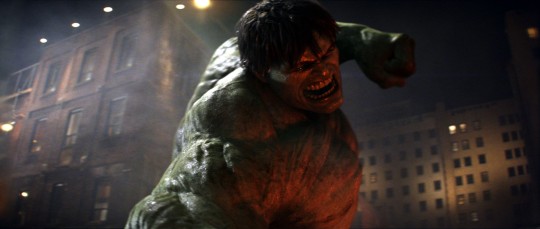
23. The Incredible Hulk (2008) It’s a shame that my favorite Marvel character seems to be a conundrum when it comes to giving him a solo movie. With a decent slice of these characters, it’s about casting the “normal” version of the character, and in the case of this film, as great of an actor as Edward Norton is, I am not sure if he can play enough self-sabotaging behaviors to believably provide us with a Bruce Banner that audiences can connect with. As a result, The Incredible Hulk left us with an isolated protagonist (literally and figuratively) forced to carry audiences between long stretches absent of Hulk in his green glory.

22. Thor (2011) For a time, it seemed as if Thor was going to be the realm of the MCU where gravitas resided. The Shakespearean approach to mythic heroes adapted by Marvel was fresh at the time, as Iron Man, The Incredible Hulk, Black Widow and S.H.I.E.L.D. were around, but certainly more relatable. Bringing Thor, Odin, Loki and a host of other legendary Asgardians into the fold broadened the world, but with the entire picture of this stretch now laid out in front of us, it is clear that Chris Hemsworth had not yet found his voice as Thor. We knew he would have to earn his worthiness and his title as King of Asgard, but I doubt anyone anticipated Thor would become one of the consistently funniest aspects of the MCU... sadly, that was not yet developed in his first film, and as a result, his introduction falls to the lower realms of the list.

21. Ant-Man and the Wasp (2018)

20. Ant-Man (2015) It was not my intention to lump the Ant-Man movies together, but in all honestly, they do work best in that capacity. The events of both movies, for the most part, seem to satellite around the bigger nucleus narrative, and up until Avengers : Endgame, and appearance made by Ant-Man in the other films was cursory or meant to “balance the scales” (as in the case of Captain America : Civil War). Don’t get me wrong... Paul Rudd is a fabulous addition to the MCU family, and listening to Michael Peña tell stories never gets old, but when it comes down to the big picture, Ant-Man and his two films are not the largest puzzle pieces on the table.
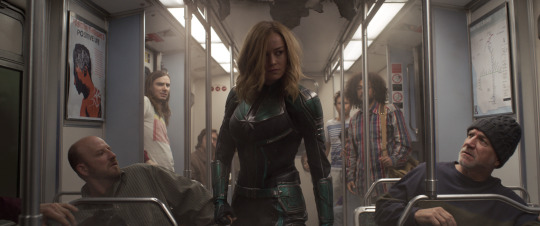
19. Captain Marvel (2019) The possibilities for an epic film were all there... Krees and Skrulls would finally get a chance at the spotlight, we were being teased going back in time without realizing how it would play into the resolution of our Infinity Saga storyline, and the final moments of the film made us question everything we’d been presented with up until that point. Sadly, however, Carol Danvers turned out to be an extremely overpowered and dangerously self-unaware character, resulting in a lack of stakes or emotional connection ever really being established. While Captain Marvel does have fun elements to it, much of the work that managed to stick was undone by her forced and underwhelming appearance in Avengers : Endgame. Of all the properties in the MCU, this one seems to have the most whispers and rumors surrounding it in regards to its production and future within the MCU moving forward, but I will be curious to see how time treats this film.
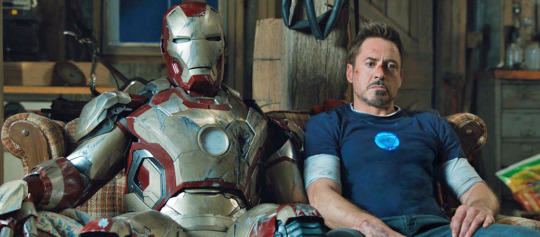
18. Iron Man 3 (2013) Up through Phase Two of The Infinity Saga, Tony Stark was always positioned as the loner of the group. With that in mind, it does seem a bit strange to me that his final solo film, and the first solo film after Marvel’s The Avengers, would find Tony back in isolation mode so vigorously. In all fairness, War Machine is there (during his brief stint as The Patriot), and Pepper Potts is given the most room to play out of all three films, but as interesting as the antagonist structure for the film is, the convoluted nature of having at least three tiers of villainy almost begs the inclusion of at least one more Avenger. Ultimately, the film does move Tony closer to the rest of the camp, but it’s odd that more Avengers weren’t involved in the actual film.

17. Captain America : The First Avenger (2011) Of all the characters fans were presented with in the MCU, it’s hard to argue against the fact that Captain America received the most rewarding arc of any character in The Infinity Saga. Every journey needs a starting point, and simply because it was the origin story, Captain America : The First Avenger was never destined to be the best of the MCU. Visually, the MCU was still figuring a few things out, so some of the scrawny Cap scenes look awkward, but by the time this film is all said and done, all of the honor, character and heart needed to propel Cap forward was present and accounted for.
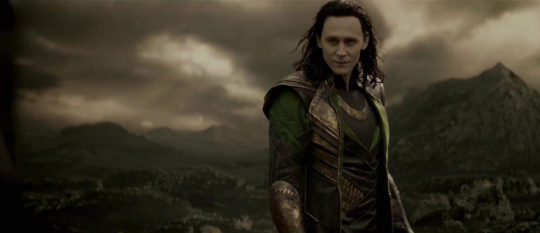
16. Thor : The Dark World (2013)

15. Iron Man 2 (2010) Maybe it’s a recencey bias thing, but I really enjoyed Thor : The Dark World and Iron Man 2. Up until deciding to make this list, I’d not seen either of these films, and it was largely due to the negative reactions I’d heard from most fans and critics. Thor : The Dark World gave us brief glimpses of where the Thor character was headed, it was a great look for Jane Foster (who is seemingly on her way back into the mix), it opened up some mystic doors that we will likely be exploring moving forward in the MCU, and due to these mystic elements, we may have seen the beginnings of S.W.O.R.D., who is already making its presence felt in Phase Four. As for Iron Man 2, we are given the polar opposite Tony Stark from his introductory movie, and due to his seemingly unstoppable mission to erase himself, War Machine is given autonomy, and the beginnings of the Iron Legion are built. Perhaps its a bit of a revisionist lens as well, hence these two being grouped together, but time seems to have been very kind to these two films, despite their flaws.
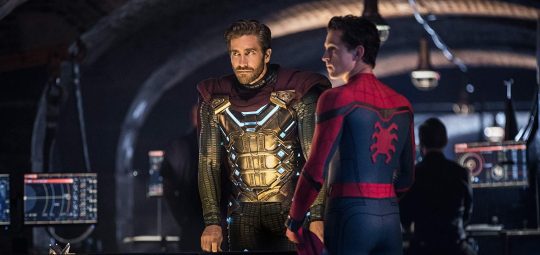
14. Spider-Man : Far From Home (2019) Avengers : Endgame would have been a perfect place to close the door on The Infinity Saga, but that monumental task was appointed to Spider-Man : Far From Home. Perhaps it was that implied burden that made the film feel a bit buried under the weight of expectations. There are certainly calls to a post-Tony Stark snap present throughout the film, but Mysterio’s plan runs seemingly independent of any previous events shown. The mid and post-credit scenes certainly tease big things for the future, but even before COVID-19 flipped the script on the industry, it was uncertain where things where headed as the new phase unrolled. This film was enjoyable, but almost feels like a stand-alone trapped on a bridge between two worlds of narrative.

13. Iron Man (2008) The one that started it all. I’ve never been the biggest Iron Man fan, but I can certainly respect the large risk that Kevin Feige took by kickstarting his empire with a character seemingly caught between fame and obscurity. Tony Stark has enough Bruce Wayne in him to make him an intriguing character, but Iron Man and Batman could not be more different from one another, which immediately gave the MCU a fresh feel in light of them using a Silver Age character. The pool of household name talent was limited, as Sony was sitting on Spider-Man, the X-men and the Fantastic Four in 2008, but ultimately, Iron Man was a roll of the dice that paid off in a major way.
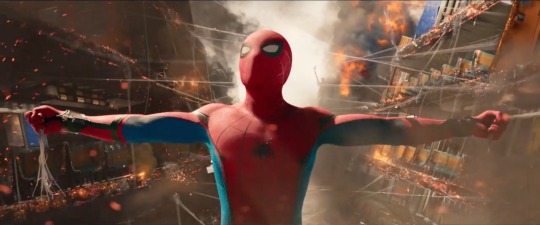
12. Spider-Man : Homecoming (2017) Spider-Man is such an iconic character that it is sometimes hard to believe that he was not always involved in The Infinity Saga. Tobey Maguire was the definitive Spider-Man to many fans, and Andrew Garfield was starting to build a cult following, but after a bit of legal ping-pong, Captain America : Civil War went from being an anticipated mess to possibly a shadow of its comic book counterpart when Spider-Man appeared in the trailer. Tom Holland brought a pitch-perfect voice and sensibility to the character, and Spider-Man : Homecoming drove those feelings home (no pun intended). It wasn’t like Spider-Man needed a boost in tandem with his entry into the MCU, but his introductory movie did most everything right (including assuming we were WELL AWARE of his often repeated origin story).

11. Guardians of the Galaxy (2014) Out of everyone that the MCU has introduced to the masses, it is safe to say that I knew the least about the Guardians of the Galaxy... in fact, my closest tie to knowledge of their existence came in the form of Howard the Duck, who shares that section of the Marvel comic universe with them. Marvel Studios had already made me enjoy films about Thor and Iron Man, two characters I did not consider myself a fan of prior to their films, so I went out on a limb in hopes that Marvel could sell me on characters I had zero connection to. Guardians of the Galaxy did provide another set of colors in the Marvel spectrum, and it helped open the door to Marvel’s space-centered stories, but it wasn’t until the sequel that I went back and really found an appreciation for Guardians of the Galaxy, which I will expound later. That being said, Guardians of the Galaxy is another Marvel film that has been benefited by time and revisitation.
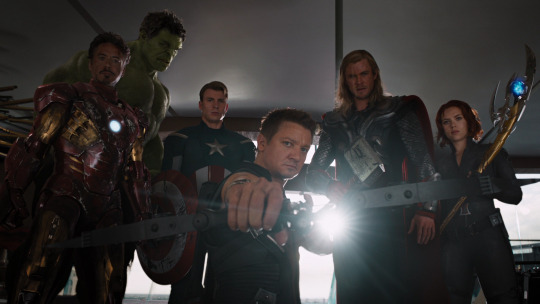
10. Marvel's The Avengers (2012) The main pieces had found their way to the board by the time Captain America : The First Avenger was released, and it only seemed like a matter of time before the big players would cross paths. Rather than build to a mass collaboration via smaller duos and groupings, Marvel went all in to close Phase One by locking in The Avengers as the collective stars of The Infinity Saga. Loki found new agency as their protagonist, but he was really just a smokescreen for the big bad of the entire saga, Thanos. The entire run of 23 movies can be summed up or represented by the iconic shot that rotates around our heroes when they stand shoulder to shoulder for the first time, staring up at their enemy emerging from the sky. There was no turning back at this point, and this is largely due to the wonderful execution of one of the MCU’s key films.
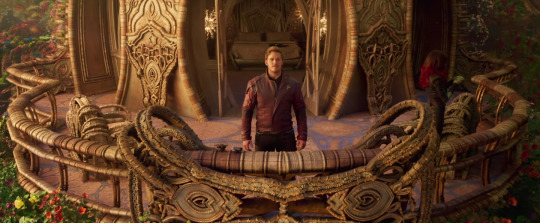
9. Guardians of the Galaxy Vol. 2 (2017) I’m really not sure why Guardians of the Galaxy didn’t connect for me initially, but after watching Vol. 2, I felt a deeper understanding of Peter Quill, the relationship between Gamora and Nebula, and I came to love Groot and Drax even more (who didn’t immediately love Rocket Racoon?). Kurt Russell was the evolved mirror to Chris Pratt that I didn’t know I needed, and the soundtrack contained more songs that spoke directly to me than the first film. Some of the set pieces were downright beautiful in this film, I lowkey became a big fan of Mantis, and Yondu’s story culmination may have been the first time the MCU brought a tear to my eye. Guardians of the Galaxy Vol. 2 may deceptively be the most emotionally powerful of all the MCU films, short of Avengers : Infinity War, and for that, it must be respected, considering it all came from a little known band of upstarts.

8. Captain America : Civil War (2016) While Marvel’s The Avengers may be the first true “event” film in the MCU, the first major “event” attempted in terms of historic Marvel stories was the infamous Civil War run. A weird mix of anticipation and fear existed in the time preceding the film’s release, as a number of key players from the comic book storyline were either not available to the MCU or had not yet been introduced into the MCU. Speculation between who would be emerging, omitted and adjusted flew back and forth, but in the end, we were not only presented with a riveting triangle of emotion between Tony Stark, Steve Rogers and Bucky, but Spider-Man and Black Panther stepped into the spotlight (with a little dose of Ant-Man thrown in for good measure). Had the MCU waited for a different phase, there’s no telling how many heroes and villains could have ultimately been involved, but considering what they had at the time, the MCU definitely exceeded expectations and created their own iconic version of a Marvel narrative hallmark.

7. Black Panther (2018) Outside of the final two Avenger’s, there wasn’t a more anticipated or well-received release (to my knowledge) than Black Panther. After bursting onto the scene in Captain America : Civil War, it seemed everyone was ready for more of King T'Challa, Black Panther and Wakanda. Chadwick Boseman became even more of a fan favorite than he already was, and Black Panther became the first MCU film to be nominated for Best Picture at the 2019 Academy Awards. Marvel presented Wakanda, and Africa in turn, with the utmost cultural, historical and social respect, and short of a slightly underwhelming finale in terms of visual effects, it was hard to hang a complaint on Black Panther. If the MCU had to pick a single film that they were most proud of, I would not be surprised if this was the one that was chosen.

6. Doctor Strange (2016) As a fan of science fiction, mysticism and overall weirdness, I was incredibly hype for the announcement and release of Doctor Strange. Of all the active characters in the MCU at the time, Doctor Strange was the most obscure that I was already familiar with, and his introductory film did not disappoint. The visual representation of the mystic arts was brilliant, casting Tilda Swinton as The Ancient One was a stroke of genius (despite many that voiced reservation to the choice), and the introduction of different dimensions and realms to the MCU hinted at the future that was to come. With Doctor Strange and the Multiverse of Madness coming in sooner than later, it is almost certain that I will be revisiting this film, and I hope that as time goes by, it finds a bigger audience with a deeper appreciation for it.

5. Thor : Ragnarok (2017) If I think about it hard enough, I can probably find a character that will contradict this statement, but I’m hard pressed to think of a character than took a bigger personality jump between individual films than Thor did between The Dark World and Ragnarok. We got shades of a new Thor in The Dark World, and he was really starting to come out of his shell in Avengers : Age of Ultron, but I’m not sure if anyone expected for Taika Waititi to not only turn Thor into possibly the most loveable Avenger, but make his third film a psychedelic masterpiece of fun. Thor and Loki have never had better chemistry, Cate Blanchett was surprisingly well cast as Hela, and most everyone’s favorite MCU iteration of the Hulk came to life (not to mention a brief nod to Beta Ray Bill being present for keen viewers). It may not be the best film in the MCU, but Thor : Ragnarok is almost certainly the one viewers gravitate towards if they make a quick selection.
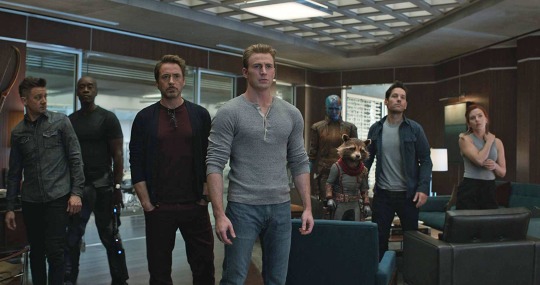
4. Avengers : Endgame (2019) How do you end a story arc that spans more than 20 films? Well, for starters, you bring every character to the table, collect every expectation that fans have for them, and then kick all of those expectations to the side and forge a completely wild, new and unexpected path. For a large portion of Endgame’s runtime, it is tonally and stylistically different than any other Avengers film, but near the end, when the rubber hits the road, Thanos and his legions of followers take part in one of the most epically satisfying stands against our heroes already present, only for the world of the MCU to open up and rain the most enjoyable and acceptable fan service ever to be captured to film, including the most iconic Captain America moment of all time.

3. Avengers : Age of Ultron (2015) For a long while, this film stood as my clear-cut favorite in the MCU. I didn’t even know I was a Vision fan until he emerged from his chamber, and the introduction of Scarlet Witch has brought me nothing but joy. David Spader brought some of the best antagonist personality in his powerful portrayal of Ultron, and the party scene provided one of my favorite non-action sequences in all of the MCU. The interactions between the Avengers had the best balance of all their collaborative films during Age of Ultron, and Scarlet Witch took each of our heroes to the darkest corners of their mind. Perhaps people had other ideas in mind when they learned that Tony and Bruce’s murderbot was due for a screen appearance, but for my money’s worth, Age of Ultron was the first Avengers film that blew my mind, and still stands as my personal favorite of the Avengers movies.

2. Avengers : Infinity War (2018) Easily the most epic of all the MCU films, Infinity War set the stage for a truly iconic struggle between the Earth’s mightiest heroes and the seemingly unstoppable Thanos that had been promised over many, many films, and in the opening rounds, Infinity War delivered. For all of the combinations of characters we’d been provided, we’d yet to see Tony interact with Doctor Strange or Star-Lord, and each of those meetings yielded hilarious results. The stakes had never been higher prior to Infinity War, and the costs had not been greater up to this point. I personally remember people in theaters being nearly moved to tears when their favorite heroes (especially Spider-Man) began turning into dust, like they were watching Schindler’s List. If the MCU collectively raised the bar for comic book movies, then Infinity War raised the bar for the MCU.
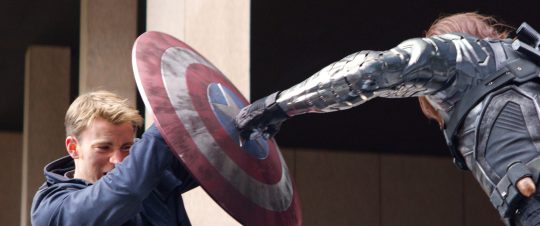
1. Captain America : The Winter Soldier (2014) The MCU has more than a handful of classic films under their belt, but Captain America : The Winter Soldier is probably the sole film of the MCU that feels like a proper action/adventure suspense-thriller, like it was penned by John Grisham. The connection between Bucky and Cap is kinetic in its swings between impending hope and tragedy, and the level of combat and action in the film is second to none. This was the film where the Cap that the masses know and love stepped into his own as a hero and a leader. Of all the directors that Marvel Studios has tapped, the Russo Brothers seem to have the secrets unlocked to make a great MCU film, and Captain America : The Winter Soldier is the pound for pound best they’ve offered yet.
#ChiefDoomsday#DOOMonFILM#MCU#MarvelStudios#InfinitySaga#PhaseOne#PhaseTwo#PhaseThree#IronMan#TheIncredibleHulk#IronMan2#Thor#CaptainAmericaTheFirstAvenger#MarvelsTheAvengers#IronMan3#ThorTheDarkWorld#CaptainAmericaTheWinterSoldier#GuardiansOfTheGalaxy#Spider-ManHomecoming#ThorRagnarok#BlackPanther#AvengersInfinityWar#Ant-ManAndTheWasp#CaptainMarvel#AvengersEndgame#Spider-ManFarFromHome#WandaVision#TheBlackWidow
3 notes
·
View notes
Note
Evens for the opera asks? Thank you!!
Thank you! Here they are, finally. (Under the cut for length.)
#2, 4, 6, 8, 10: [Already answered!]
12. Favorite clueless tenor?
It’s a tie between Hoffmann (Les contes d’Hoffmann) and the Duke of Dunstable (Gilbert & Sullivan’s Patience).
14. A mezzo-soprano character you love?
Marfa in Khovanshchina. The three basses may be more politically/historically significant, but Marfa is the heart of this opera (and she gets some fantastic music!).
16. Create a hypothetical opera adaptation off of a classic novel (and cast it if you want!)
Edward Rutherfurd’s historical novels could be interesting material. (*checks shelf* I have two: Sarum and Russka.) The structure is a series of novellas, with each novella set in a different historical period, but always centered on a particular location and the same set of (fictional) families, so that you’re following them across time and seeing how they’re affected by history. You’d have to narrow the scope for an opera, maybe choose one particular novella, or a small set of scenes across eras where there are strong thematic parallels. I haven’t engaged with these books in a while, but I remember being moved to set passages to music when I was reading them, like arias from a hypothetical opera.
18. Best tenor/baritone relationship?
Skula and Yeroshka in Prince Igor are not particularly nice people, and I’m not sure I even find them sympathetic, but I’ve always thought they have a certain potential for Shenanigans. (*checks libretto* …oops, Skula is technically a bass.)
20. Favorite tenor singer?
I like Shicoff and Lemeshev a lot. They have pretty different timbres, so I like them in different sorts of things. Shicoff sings with so much passion, and has darker colors in his voice. Lemeshev is my go-to for a lot of Russian rep, including art songs. A lighter lyric voice, very well-suited to Lensky.
22. An opera that you do not vibe with. :(
I tried to watch Shchedrin’s Dead Souls when the Mariinsky had it up a few weeks ago, but I couldn’t quite get into it. It looked like a very dynamic staging, and I was curious about the folk music elements (I performed an aria from one of his other operas in a college recital once, and that was very folksy, too) — but this score didn’t catch my ear enough, and I was short on time while it was streaming, so I gave it a pass.
24. Favorite opera couple?
I’m not much of a shipper, but I think Ganna and Levko in May Night are a solid pairing. I also find Konchakovna and Vladimir in Prince Igor endearing, but maybe that’s less about character dynamics and more about how fabulously the voices blend in their duet. (Depending on the timbre of your mezzo and your tenor, it can be hard to tell who’s singing which lines! I love that.) I want to ship Olga and Lensky, but some productions of Onegin make that easier than others.
26. Favorite soprano singer?
I heard Krassimira Stoyanova in a few things recently, and thought her voice had some really interesting colors.
28. A character who deserved better?
So many. But isn’t that kind of the point in tragedies?
30. A Shakespeare play you’d like to see as an opera?
The Henry VI plays would be a *mess*, but I’d love to see someone try.
32. Your favorite secondary/minor character in an opera?
The Muse/Nicklausse in Les contes d’Hoffmann. Genderbending trickster sidekick whose goal is to get Hoffmann to stop falling in love with doomed ladies and focus on his writing. This character appeals to me in a lot of ways.
34. What would a gender-swapped version of your favorite opera (or any opera of your choice) look like?
Fun fact: There’s a discarded stanza from near the beginning of Ch.3 of the novel where Pushkin considered having Onegin fall in love with Tatyana after their first meeting, instead of the other way around. Maybe a gender-swapped Onegin could play off of that alternate storyline in some way? (I’m picturing a massive rewrite of the opera, with themes repurposed in meaningful ways. It would be highly controversial to a lot of people, but if done well it could be great fun.)
36. Favorite opera trope?
When they hang a lampshade on the tropes. Gilbert & Sullivan are very good at this.
38. Favorite mezzo-soprano singer?
Olga Borodina. A luxurious voice, somehow dark and bright at the same time.
40. You can steal one costume from an opera production to keep — what is it?
A few years ago, the local opera company had a costume sale to clear out some of their storage. I got this cravat for very cheap. It goes well with a number of my waistcoats and I have found many occasions to wear it.

42. Talk about an opera that you don’t normally talk about.
I watched a really interesting production of Charpentier’s David et Jonathas several years ago. The ballet sequences were repurposed into a series of staged flashbacks, which (among other things) introduced Saul’s wife and showed her death before the events of the main story. Then, in the scene where Saul consults with the Pythoness, the tenor who played the Pythoness was dressed as Saul’s wife. But his mannerisms made him read as some kind of otherworldly trickster. There was very much an unsettling sense of what are you and why are you wearing her face? The chorus women were also all dressed as Saul’s wife, and they drifted mindlessly around him as the walls of the set kept shifting and repartitioning into different rooms. The effect was fantastically creepy and contributed to the theme of Saul’s madness. I have no idea what this scene is usually like in a more traditional production.
44. An opera character you’d want for a best friend?
Muse/Nicklausse, again.
46. An opera you love more for the plot than for the music?
I saw the local opera company do Britten’s The Turn of the Screw a couple years ago. It was a very compelling piece of theater — wonderful acting from all the leads, shapeshifting dreamscape of a set. The music made very little impression on me.
48. Most musically difficult role you’ve seen/heard thus far?
Hermann in The Queen of Spades. He’s onstage almost constantly, and sings in every. single. scene. That must take incredible stamina.
50. An opera you’d recommend to opera newbies?
Maybe I’m not the best person to ask. I know what I like and I’m always excited to share my faves with people who seem interested, but the set of operas I’m familiar with is a little skewed. (As you can see by my other responses!)
[opera asks]
7 notes
·
View notes
Photo
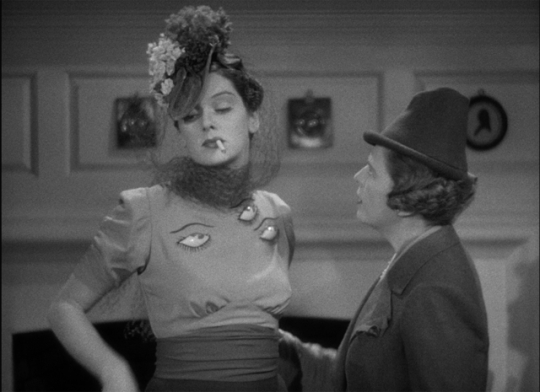
Happy International Hat Day: Bowlers and Fedoras and Cloches, Oh My! By Jill Blake
Hats have been a staple in fashion for centuries, with origins that date back to ancient Egypt around the year 3200 BC. Of course, hat styles have changed over time, but their purposes are pretty much the same: either functionality by providing protection from the sun and other elements, or merely serving as a fashion statement. Historically, hats also often represented an individual’s social standing, with different types of hats worn by certain social classes and for certain events or occupations, from ornate wide-brimmed hats, to high quality bowlers, to newsboy caps. Hats were also part of social convention, with men wearing hats when outside and women wearing anything from pillbox hats to fascinators to complete their outfits for church or other social functions. For International Hat day, here’s a list of some popular hat styles of the 20th century. Many of these hat styles can be found on the TCM shop.
Pork Pie Hat
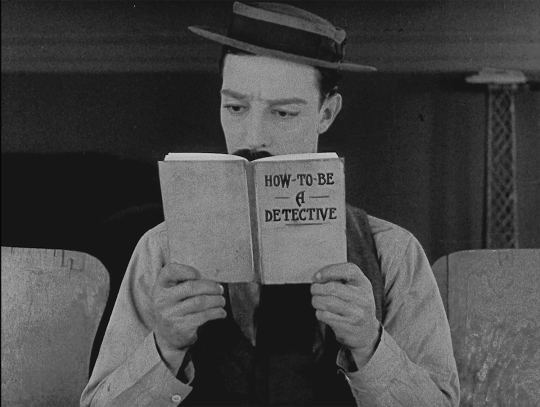
The pork pie hat dates back to the early-to-mid 1800s and was quite popular with men. The hat was often made of high-quality felt, but also could be made out of cotton or straw. The pork pie, or “stingy brim”, hat has distinctive features with a low crown and narrow brim. After the Civil War in the United States, the pork pie wasn’t as popular in men’s fashion. In the 1920s, silent film star and director Buster Keaton made the pork pie an integral part of his on-screen persona, helping popularize the hat once more. And in William Friedkin’s THE FRENCH CONNECTION (’71), Gene Hackman’s character, Jimmy “Popeye” Doyle, sports a pork pie hat.
Bowler Hat
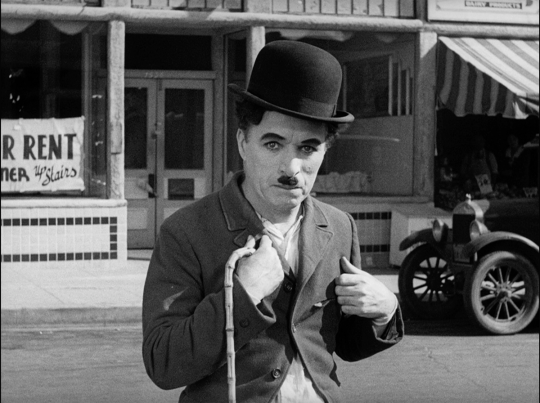
The Bowler hat originates from England and was created by Thomas and William Bowler in London during the mid-1800s. The Bowler is typically made of felt and has a rounded crown, narrow brim and is very durable. While it looks formal by today’s fashion standards, the bowler was considered a more informal hat for day-to-day wear and was mainly worn by middle and upper-class men from butlers and valets, to bankers and members of the aristocracy. Perhaps the most famous bowler in classic film belonged to Charlie Chaplin, who wore the trademark bowler for his iconic Little Tramp character in films such as MODERN TIMES (’36), CITY LIGHTS (’31), and THE KID (’21). Stan Laurel and Oliver Hardy also famously wore bowler hats in many of their films, like the short ANOTHER FINE MESS (’30). Other examples include Jack Lemmon in Billy Wilder’s The Apartment (1960) and James Cagney during the “Harrigan” musical number in Michael Curtiz’s YANKEE DOODLE DANDY (’42).
Fedora

The fedora is perhaps the most iconic hat in film history, particularly throughout the 1930s up through the 1950s. It’s typically made of high-quality felt, ranging from wool to cashmere to mink. The hat also usually has a wide, soft brim and a pinched crown that is indented at the top with some kind of ribbon running around the base of the crown. The fedora dates back to the 1890s and was originally considered a ladies’ hat. By the 1920s, the fedora was popularized by male members of the British Royal family and became a staple of men’s fashion. By the 1930s, the fedora was associated with gangsters and tough guys, as well as private detectives and plain clothes police officers. Almost every modern film from the 1930s through the 1950s features a fedora, including James Stewart’s Macaulay Connor in George Cukor’s THE PHILADELPHIA STORY (’40); Dick Powell’s Philip Marlowe in Edward Dmytryk’s film noir MURDER, MY SWEET (’44); and perhaps the fedora’s most famous wearer, Humphrey Bogart as Rick Blaine in Michael Curtiz’s CASABLANCA (’42). Ingrid Bergman also wore a variation of the fedora as Alicia Huberman in Alfred Hitchcock’s NOTORIOUS (’46).
Fascinator
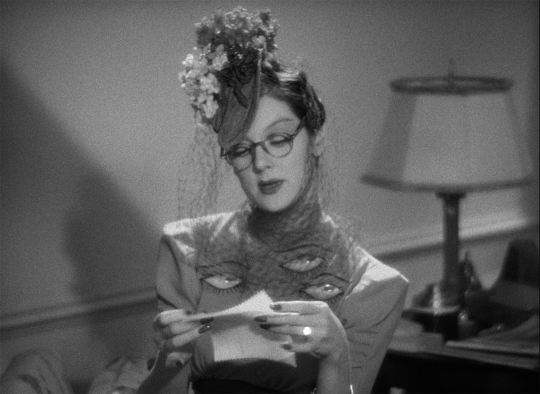
The fascinator is more headpiece than an actual hat, but has long been a staple of women’s fashion, particularly in Europe. Fascinators are typically decorative and are clipped or pinned into the hair. They can be made of a wide-range of materials, including silk, wool and feathers and can have netted veils. Fascinators are mainly worn in traditional or formal settings, such as during church services, weddings or funerals. There are countless examples of fascinators in classic film, but one of the most popular is the one that Rosalind Russell’s Sylvia Fowler wears with her Adrian-designed eyeball blouse in George Cukor’s THE WOMEN (’39).
Top Hat
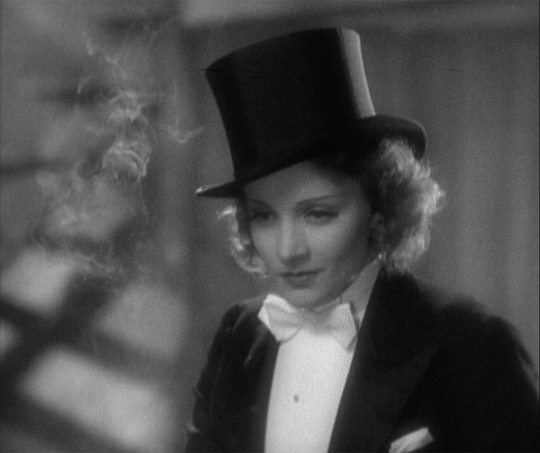
The top hat is one of the most recognizable hats in history. It is typically associated with formal dress dating back to the 1700s all the way up to the mid-1900s and is still worn today for certain social events. The top hat is tall, with a flat top and wide brim, and is usually made of silk, beaver fur or cloth. The hat was typically associated with wealth and prestige but eventually became accessible to a wide-range of social classes. Like the fedora, the top hat is featured in countless classic movies. Fred Astaire often wore one in his RKO musicals with Ginger Rogers, such as the appropriately named TOP HAT in 1935, directed by Mark Sandrich. Then there’s Fredric March, who always wears a top hat for a night out in Victorian-era London, whether he’s Dr. Henry Jekyll or his sinister alter-ego Mr. Hyde. But the top hat wasn’t limited to men—Marlene Dietrich famously wore one in her first American film, Josef von Sternberg’s MOROCCO (’30), as did Josephine Baker—both women pushing the boundaries of gender and redefining femininity.
Cloche Hat
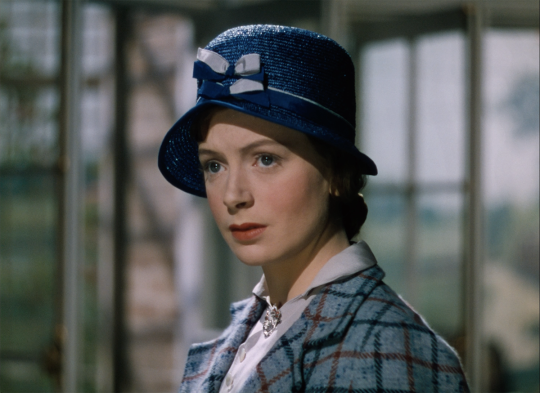
The cloche hat was one of the most popular hats for women in the early 20th century. The cloche dates back to 1908 and was designed by French fashion designer Caroline Reboux and named for its bell shape. The cloche was one of the most versatile hats in a woman’s wardrobe, worn with casual, everyday clothing, as well as fancier versions for evening wear. The cloche was also popular because it accentuated the shorter hairstyles that were becoming more popular at the time. Joan Crawford, Josephine Baker, Nancy Carroll, Norma Shearer and Louise Brooks all famously wore cloche hats. One of the most stunning examples is in Michael Powell and Emeric Pressburger’s technicolor masterpiece, THE LIFE AND DEATH OF COLONEL BLIMP (’43) and worn by Deborah Kerr.
Hunter/Trapper Hat
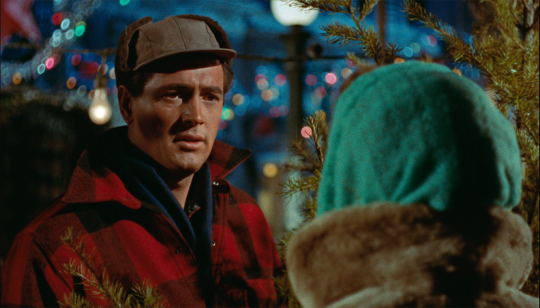
The hunter or trapper hat is sort of a variation on the deerstalker hat, typically associated with the literary character Sherlock Holmes. The trapper hat can be made of fur, leather, wool or flannel, and it has ear flaps that can be tied back. The hat is more function than style, providing warmth for a variety of outdoor activities such as hunting, fishing or selling Christmas trees, like Rock Hudson’s Ron Kirby in Douglas Sirk’s ALL THAT HEAVEN ALLOWS (’55).
Bonus: Doris Day’s Many Hats
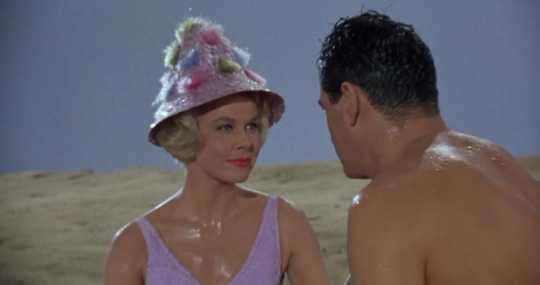
Doris Day has rocked some hats in her day, particularly in her three films with Rock Hudson: PILLOW TALK (’59), LOVER COME BACK (’61), and SEND ME NO FLOWERS (’64). Pillbox hats. Cloche hats. Fur hats. Straw hats. Bubble hats. Bucket hats. Sun hats. And plenty of “I-don’t-know-what-that-is-but-it’s-fabulous” hats. In the late 1950s and 1960s, Day re-popularized many of the hat styles from the 1920s and 1930s, with a funky, mid-century twist. Doris wore them all and she looked absolutely fabulous.
#International Hat Day#Jill Blake#Doris Day#Rosalind Russell#Rock Hudson#Ingrid Bergman#Buster Keaton#Charlie Chaplin#Deborah Kerr.#Marlene Dietrich#TCM Shop
456 notes
·
View notes
Text
Up the down way
So I once wanted to write a FFIV AU, with a very different universe and an OC Callian Jackson. here was my attempt at note taking.
Callian is here in the story as Kain and Rosa's best friend. Kain and Rosa are dating, and with Callian here, there is a different dynamic to their friendship, as Kain has two girls teaming on him to do things, and is probably not left alone to brood as often as he would like, among other things. Callian is mostly here, because Cecil was being raised elsewhere, and Callian is a girl who lost both her parents in the war, and chose to take up the way of the dark knight, and passed it, becoming good enough to be a Captain of the red wings. She is not a cannon clone of Cecil or Kain, though she may take some elements of the roles, she is ultimately her own weirdo in the story. I do not intend her to be an expy, and hopefully she does not come off as a Sue either. Cecil is still in this story, just obviously not here in Baron. He'll probably show up briefly soon. The characters will not be as you remember, because the blue planet they grew up in is not the one we are used to, and there are some odd consequences to that. The social chemistry of the world is different, and so are they.
Is a bit of a parody and an AU Alice in Wonderland style, in that the characters can be downright odd.
Plot: When Callian Jackson's invasion of Mysidia goes wrong, she is sent to be a delivery person as atonement. Callians invasion likely went wrong because of a stray berserk spell, and her soldier's went nuts on the people. Never less, a good commander should rise above that, and accomplish the mission, keep the men's respect. Kain, wondering what Rosa was talking about, Comes into the room to ask, and ends up getting sent alongside Callian to Mist. ---
The scene starts with Callin quietly but furiously questioning her men, and her men too ashamed to say anything to her, beyond monster warnings. She begins, quietly, and intensely angry, getting details about the mission , until a monster attack distracts her, much to their relief. To the king, she is quietly upset, trying to hold her temper. Kain wanders into the room, and gets sent along. She does let it out when Rosa comes to her room, as Rosa often serves as an outlet.
Differences from IV: Kain is dating Rosa, and is not nearly as broody or secretive in part to having two woman who would pester him if he was off. Rosa is a lot more outspoken, and has Scrying abilities, as well as being Paranoid of Troians. Callian had a crush on Kain, but when Rosa asked him out, they talked about it, and Calians happy for them. I think in the original, Cecil was a peacemaker who asked Rosa to leave Kain alone,even when he deserved a chewing out.
Day two: They leave the castle with a feeling of Destiny in their hearts. At Baron, Calian goes and finds stuff with "treasure hunter senses", and Kain goes to buy supplies, (bartering , an act learned from Rosa). While Kain contemplates sporks, he runs into fan-girls and an eager dancer, and helps Calian take a tent from a river when he jumps. Once out of Town, the two decide to train like mad, then ride the Chocobos to the mountain , so they go south. They earn goblin and cocatrice. Meanwhile, at the castle, a Scrying Rosa sees them going the wrong direction, and decides to catch up with them using many Hermes sandals, and remembering why using too many items outside of battle is bad (made her more susceptible to the illness later). Meanwhile, Callian and Kain reach the grove after fighting enough battles with goblins to win the summon , and grab Chocobos. When Rosa arrives after, she sees a black Chocobo and uses it, much to the pale haired man's upset utterances. -(Yes that is Cecil, Lol)-She flys over the mountain and lands , deciding to rest in the grasslands. Meanwhile Callain and Kain arrive at the mountains, and take a rest instead of going in and facing zombies. (Rosa tells many horror stories) They get through the cave fine, and decide to rest in the tent before entering Mist.
Day two, part two: Well rested, our hero's enter the cave and run into porcupines and the dragon of Mist. Kain is not fond of attacking Dragons, so they try to run, only to have to kill it anyways. Entering the village, bombs attack from the Carnelian Signet .Rather than Come to the logical conclusion, Callain concludes its a test and she is meant to be foiling a ninja plot , and begins shouting orders and getting people to safety "taking command" of a chaotic situation.She decides to evacuate. Following orders, Kain goes to help a little girl, who- furious her village is being invaded- summons Titan, separating Kain from Callian. Meanwhile Rosa, believing they would be taken to Kaipo until they were transferred to Fabul and shipped to Troia, wanders around outside of Kaipo, trying to find the blasted place In the desert. She runs into Tellha, who informs her she is not the Mage he's looking for.
Day three: Kain wakes up, and decides to find a place for the little girl he accidentally orphaned to sleep, and perhaps be adopted. So he goes to Kaipo, a neutral city, and more importantly, close. In the middle of the night, three Guards come for Kain and Rydia. Kain sends them away stating Calian asked him to watch this kid. The Captain then asks if Rosa was here, since she has been missing and that their purpose here was a search party. Kain offers to take over the desert search party, much to their relief, and they go. Kain is glad that encounter could be solved by negotiating, as that was one of Callins competent Captains. Meanwhile Rosa collapses at Kaipos gates.
The next day, Rydia wakes up and can't remember the attack, or what she's doing here, and asks where her mother is. Kain informs her that her mother is dead. She is quiet after that. They hear some rumors about a girl with desert fever, and some more about the prophetic chick Anna who everyone had talked about the other day when they were looking for an inn. They find Rosa and discover she was the one with desert Fever. Kain goes off to find a sand pearl, and Rydia comes with him. In fact she refuses to leave him, very assertively. Kain gets Rydia some weapons. Rydia proves competent at Healing, and distracting monsters with weak attacks for Kain to counter. They use this strategy since Kain can't jump and leave her. Beyond battle, Rydia is quiet and unobservant in terrain. Kain has to hold her hand to prevent her wandering off.
Randomly added note.(Edges difference in attitude comes from a more comprehensive training due to an attack on the palace he almost died at. He is quieter and more ninja like.)
R.A.N2(Edward is determined to get the prophet who tried to save him back! He is more determined than sad.)
R.A.N3( Palom is already a sage, spellwise. He had to learn some cure magic until someone gave Porem a cure staff. The problem with the twins is that they are five year old prodigies, who are probably pushed because of paranoia over Baron. They have some issues. Palom has high standards, is hypercritical of himself, and uses lots of false bravado. He needs the rest of the world to believe he's awesome. Porem has a terrible bedside manor, and anger management issues, so carries a cure staff, so when she hits people, it heals them. They are quite nervous about teaching her hammer style fighting, even if she might be good at it, because no cure hammer has been invented. )
RAN 3.5: (Kain has to protect them on his way up the mountains. That means covering and countering the attacks directed towards them in battle, taking breaks for them, and giving them piggybacks. He also gives Rydia piggybacks. The trip up the mountain is a long and grueling journey. PS: Write a story about Cecil and the twins climbing the mountain, frame as elders revenge)
Finally Kain and Rydia arrive at the cage and meet Tellaha.
Rn4( Tellaha can see the future. Or at least possible outcomes of the future. Kain being here, makes him realize something is different, but he can't quite remember what. He has trouble differentiating between what is a possibility and what is real, leading him to sway between right for the wrong reasons, and completely off base. He seems to believe in the original timeline at the moment, and may leave on a quest for Cecil. Tellah is also amnesic, and can not remember past Anna's eleventh birthday)
Rn4.5 (This world's Anna is kind of Joan of Arc, and Callian’s main opponent, and they will clash more throughout the fic. Callin kind of sees her as worthy adversary, and keeps her alive, but gives her to Kain so she doesnt have to explain it.)
Tellaha informs them they are late, much to their confusion, and they enter the cave. Throughout the cave, they find several potions, and pieces of dark knight armour and a sword . Kain notes he does not have to worry about getting Callin a birthday present now. Tellaha focuses on teaching Rydia thunder and ice spell words, as fire will not be very useful in an water cave. Rydia tells them the smell of smoke terrifies her.
Kain and Tellaha reconsider their plans to have goblin for dinner, in favour of smoked goblin. Then again, fire keeps away Zombies. Kain and Tellaha debate the merits of fire as they continue through the cave.
(RN5: Rosa has a crazily complex family tree that includes, but is not limited too, Tellaha &Anna, Palom&Porem& Sheila[ Yangs wife]. It debatably includes Rydia. Maybe. Callian of course has no idea of this when she sits down and tries to relate to Rosa just how odd this is.)
(RN6: Rosa hates Troians. Troia, in this universe, are the Amazonian-esque city. They are fierce magical archers who steal or entice men into their castle, in an attempt to sire strong warriors. As a magical archer (white) Rosa is often accused of being one, and has grown a tad resentful. It doesn't help that Rosas family is from Mysidia, Barons former close ally [before the attack], who is traditionally rivals with Troia. Kain has huge respect for ninjas, like Callain has for monks )
After a brief rest, Tellah attacks Kain, asking where they are, who they are, and what happened to his daughter. Kain reminds them of the current quest, and Tellah asks where Cecil is. Kain asks who Cecil is, and they continue on through the monster packed cave, to face the Octomamoth. Kain has to keep to the strategy of defending Tellaha and Rydia, and countering the monsters attacks, while Tellaha and Rydia put their lightning based attacks to good use. It's a fairly long and painful battle, but they emerge victorious. Upon exiting the cave, they see an attack on Damcyan in the distance. They go to investigate.
Upon entering Damcyan, they meet Calian at the entrance, with Anna unconscious. Tellaha is out of it. Calian asks if they have seen Rosa, as she has gone missing. Kain affirms they have, and that she has desert fever, and they need a Damcyan person to get a sand pearl. Callian tells him, that although she still feels disturbed with Baron actions of late, she's happy to report, there were fewer casualties, her men were controlled in temperament, and once the tactician was knocked out, resistance fell apart. She believes Anna may be a genius tactician, and brilliant leader.
Upon seeing the tactician Anna, Tellaha attacks Callian, accusing her of being a spooney bard who ran off with his daughter, married her without permission , and got her killed.
Callin tells Kain to keep his companions under control, and get their stories straight. She also insists to Kain she is not a lesbian, and that she better leave if he wants help from the Damcyains. Before going, she tells him she found this among Mist, and gives Kain the bomb item hoping it will be useful to him.
Kain tells Tellaha he was attacking the wrong person, and they should go inside. They see people bringing a either pot downstairs to the wounded, and begin healing them. Rydia and Tellah spend time helping with magic, and Kain uses first aid, and helps with moving people downstairs. Eventually he comes across Edward mourning his mother and father. Kain, having some tact, leaves him alone for now. Once the cleanup is done, they begin moving the bodies Kain comes up, to talk with Edward. (Rosa has had him come on talks to patients families and he and Callian have also done so to their soldiers families). Kain is still quite blunt, but has learned some thing about talking to grieving people. Sorta.
They have a talk, and he manages to convince Edward to both help them get the sand pearl, and warn Faboul, once his kingdom is better. Rosa being a healer is mentioned. Rydia has no outburst. Once a second for Edward is appointed, they go to move out. Tellah yells at Edward asking what he was doing with his eleven year old daughter, and is asked what he is talking about by Edward. The only Anna he met was the glorious savior of Damcyan.
Tellah gets mad and runs off, much to Kain and Rydias discomfort. Finally they set off for the anitolin den. Much to Kains annoyance, he is still the group shield. The Antoilon is not a difficult foe, and after many battles they earn not only the sand pearl, but the elusive rainbow jelly for Edward, who is not going to give this one to Callain.
(RN7 Callain is crazy prepared in some ways. She insists on fighting many monsters with Kain outside of town, to stock up on items & Gil harvester as an ability. She and Cid had airships capable of invading the moon, that were destroyed by the red wings, because they left them with the RW in preparation to invade the moon. She also has oddly convenient timing, and a love of training people, with a dream to fill the bestiary. She buys every weapon, shield, ect. It's why Kain had Goblin on him. )
They then battle their way out of the cave, and take the hover across the shoals. They fight a few battles and get cockatrice summon.
Rydia is pleased. Rosa is revived.
The story goes on, but I haven't moved far past that point.
So some explanations and headcanons to make sense of this verse
Baron is at war with Ebalan. The crystals being stolen and the army, and Callian’s explanation of “foiling a ninja plot” are tied to this. The war started over a catastrophic failure in marriage negotiations.
Rosa is the current heir of Baron. She is tied to the lineage of the throne through her grandmother, a princess who married a mysidian mage, who had her mother, who married a dragoon in Barron. It was a scandalous story back in the day, although it is kept on the down low now that the king has fathered no children, and they are at war. Kain is looked at as the future ruler, because of this. Politics will play a part, particularly during the Fabul castle invasion. Also Rosa needs to be depicted with more muscle please, she wields a bow for crying out loud. She should be soo buff.
There are rumors that Calian is the heir. Callian plays along with this to protect her friend.
Calian is loyal to her friends, but she is also loyal to her country and the people she leads. She is not leaving on Kain’s quest because she intends to take care of the people back home. I wanted to contrast the personal reasons of Kain being an antagonist from cannon, and avert brainwashing. She’s not as blind as she pretends to be, and comes up with some very bizarre explanations to others in the intention to subvert the malice in her orders. She won't be able to look away forever, but in the meantime she can use “alternative explanations” to do things like prevent Mist from being a genocide, or win Damcyan with less casualties ( Anna of Arc was a pretty big factor in this too). The surviving summoners will play a part later.
Who cast the Berserk spell is a small ongoing mystery. (The brainwashing is not contained to Baron)
At this point in the story, Rydia is amnesic, and I tried to include some realistic symptoms of that. She is also under the impression that Kain is her previously unmet Dad, who came for her after her mom died, and does not remember the invasion, probably the trauma from it. The “Kain is secretly my dad” is not revealed until after the Faymarch, because it had no reason to come up, and it's pretty hard to dissuade her of it after she has lived with it for years.
Oh, heres some older notes
-“Honesty, my first attempt went from crack to serious, to crack. Like at the beginning, I decided there's no way the mages should be that easy to defeat, so I decided that a berserk spell had been cast on half of both armies. Of course, it's a pretty chaotic battle between being turned into frogs or pigs , and the fire spells, the mages berserking and everything. So, Calian decides, let's complete the objective, get in, get the crystal, get out.
So once she recalls her troops, she is on the airship, and trying to figure out WTF happened. Of course back home!e, she is responsible, and the king is questioning her competence there. He sends her on a milk run to deliver this ring to some nowhere village in the mountains.
Like in canon, Kain comes along.
Rosa talks to her to try to cheer her up that night.
The next day they go to town. Kain goes shopping, and Callian goes Item hunting. When Kain runs into a crazy dancer fangirl, he jumps off a bridge and finds Calian contemplating a tent in the water.
They decide it would be better to catch a Chocobo. Of course they run into so many goblins there they find a goblin summon. (Ffiv has a ridiculously low drop rate) . Then they set up a tent outside the cave.
The next day, they face the dragon, accidentally kill the summoner. Then they find out the purpose of the ring was to summon bombs on the village. Callin interprets it weirdly...
"It is an Ebalanese ninja plot. I must do what I failed last time and take control of the situation. Command it. Kain, help me evacuate."
So, more villagers survive, but Rydia still summons Titan
The nation of Barron is being taken over by Golbez, who is also possessed. He had the king brainwashed, then disposed of and replaced, and Barron is now making war for crystals of other nations, and bombing the village of summoners, and in cannon Cecil and Kain agreed this is not the king we want to work for. Then they are separated by a magic earthquake, and end up on opposite sides of the mountain. Cecil is left caring for the child whose mother he inadvertently killed, and Kain is presumably taken back to Barron and brainwashed.
In this one , Kain will be with the kid, and Calian will be back in Barron not brainwashed, (yet,) but loyal and willing for the time. She's a capable captain, and as long as she is loyal to home, well someone needs to lead the army.
Like Cecil, she's friends with Kain and Rosa. Unlike Cecil, Kains group dynamic is changed, because I sort of get the feeling that Cecil let Kain brood too much. Like Kain and Cecil were said to be BFF\Rivals, but the game didn't really show it much. There was a love diagram with Kain crushing on Rosa, who was dating Cecil, so I get the feeling that tension was never properly talked out in Cannon, because Kain kind of behaves like a creep towards her when brainwashed, and then apparently stays on a mountain for 30 years post game. Some shit needs to be said here.
So yah, different dynamic here
So Cailan takes Cecil's role at first, being captain of the red wings, Kains Rival, and generally regarded as essential for being a knight. She worked hard to get there, and is pretty competitive. Cecil is still around, and will show up later, as a different person with different teachings.
She is loyal to her home country and her troops, and that will get her into trouble and scapegoat in the long run.”
So Cecil. Here Cecil is still a dark knight, who grew up the apprentice of the wandering dark knight whose armor we find around the game, and is mentioned in Fabul. As an apprentice to someone who the dark knight class is a family style, he has a lot more battle techniques and equipment then in game. He is investigating why there are increasingly frequent monster attacks, and trying to find out why the world is out of balance.
Edward sincerely admires Anna.
Anna and her father have hereditary clairvoyance. It takes a toll on them as they age.
#Random K#Up the down way#Callian Jackson#kain highwind#final fantasy iv#rosa farrell#plotting#plot bunnies#the notes
1 note
·
View note
Text
Old list of M!A’s I’ve got
Sight: Muse is blind for ___
Slave: Muse becomes a maid or butler to _______ (Anon decides) for 24 hours
Toradora!: If the character is a girl, she’ll be turned into a small tiger. If it’s a boy, he’ll be turned into a dragon, for three hours.
Stuttering: You have an irresistibly cute stutter for the next _____
Little Bird: For ____, you have cute little wings. No, not big enough to fly. Yes, big enough that you might need to cut holes in your shirt.
Wingardium Leviosa!: Muse grows wings. (Or if Muse has wings, they disappear.)
Red: Muse is easily flustered and skittish. Anon decides for how long. S-senpai noticed m-m-me!
Chibi: Stuck as a chibi- adorable, but only 2'4’’ in height…
Mood: Your eyes now change in accordance with your mood, good luck hiding your emotions now. Lasts 2 days.
Pins and Needles: Muse feel as if someone is sticking needles in them for 2 hours.(for summer or winter)
Flustered: When Muse sees, (anon chooses), Muse will stutter, blush, and act like a complete klutz around the so called individual, for 3 hours.
Time Rewind: Your muse can now harness the power to change one event in their life. If you don’t choose within 24 hours your choice is lost.
Sin: Put this and one of the seven sins in muse’s ask box, and they’ll be consumed by it for five days. Gluttony, lust, pride, envy, greed, sloth, and wrath. Pick your poison~
Thunder: It’s raining outside and your muse is stuck inside with ___ (anon’s choice) and when the power goes out they cuddle to keep warm.
Working Class Punx: PAINT THE STREETS IN GLITTER AND BLOOD!
Gundam Tanaka: Animals seem to have strange and extreme affections towards you.
Forced transformation: your muse gets forced to transform to a dragon who is unable to control themself
Today’s cerberus: the muse now has two other minds in their head. One very perky and cheery and the other takes on all your muses weaknesses. When one takes over your muses form changes.
Lean On Me: With the help of ___ (anon’s choice) your muse will get through something that scared them (the anon can specify or leave it up to the mun) for 3 hours.
Wait: Muse is promised their greatest wish if they can wait, but they cannot interact with the person they love while they do. Anon decides how long it lasts.
Sensory Deprivation: You’ve just lost one of your five senses. Oh no! Anon specifies which you lose.
Alohamora!: Muse is locked away in a place specified by Anon until rescued or until specified time.
Glamour: Muse thinks they are a famous celebrity or royalty for any duration the anon chooses up to one week. It’s simply fabulous darling~
Loss: My muse loses the ability to speak or communicate in any fashion. Not even a pen and paper does them any good.
Pretty Please: My Character must grant favours of anyone who asks. So long as they say please. (Anon decides duration)
Angel: Muse is and angel for ___
Sick as a Dog: Muse is ill for 24 hours (Anon specifies symptoms).
Cough: Muse will be ill for 14 Hours
Kuroshitsuji: You’ll be someone’s butler/maid. (please specify who, it can be anyone!)
Code Geass: You can read and control people’s thoughts for 24 hours.
Chaos: It’s a mad house! A mad house I say! Muse’s personality gets flipped backwards for three days. The timid turn mighty, the charismatic turn into downers, and straight Say
characters get to kiss a girl/boy and like it.
Say You’ll Haunt Me: Muse is a ghost, whom can only be seen if they want to be. Lasts 24 hours.
Technologic: Muse is turned into a robot.
Detective Conan: For 12 hours, you look like you’re seven years old, but you have the same memories, personality, etc. that you always have.
Chained to You: Physically, you are chained to (anon decides) for _____ long. Include chain leeway (length).
Plant: Anything muse touches will grow vines and flowers on it for __
Pyro: Anything muse touches will set aflame for __
Kimblee: Muse can now cause explosions just by touching something.
Scar: With one hand, the muse can create things. With the other, the muse can destroy things.
Artificial Heart: The muse no longer feels emotions- no pain, no anger, no rage. They simply become an apathetic shell. Can be broken early if something strong enough manages to break their “emotional inhibitor.”
Ibuki Mioda: You are very cheerful and speak in third person.
Power: With the snap of your fingers you can summon anything you want. This lasts for 8 hours.
Breathe: Muse is a mermaid/merman for three days, and can’t breathe above water. Under the sea~
Eyes: Muse has lost their depth perception and balance for 24 hours. I can’t see straight!
Caffeine: Muse is EXTREMELY hyper for __
Hearing: Muse is deaf for ___
I’m Melting!: Muse cannot stop bleeding from the mouth, nose, or eyes (anon’s choice). Muse cannot pass out from blood loss.
Answer: Muse will have to answer anything that is asked of him/her truthfully, lasts 4 hours
Nice Guys Finish Last: If you’re a nice guy, now you’re bad. If you’re a bad guy, you’re now nice. If you’re somewhere in the middle, you’re now a fuckin’ cat.
Dream: Muse is able to trespass in the dreams and nightmares of others for 48 hours
Gold: Everything my muse touches turns to gold. However, once the spell ends, everything turns back to normal. Affects living beings as well.
Compulsion: Muse has OCD for ___ (anon decides primary source of obsession [number, cleanliness, etc])
Pet: Me-OW! Muse is turned into an animal of some kind for three days.
Eat: Muse get’s the stomach flu, and is unable to eat without being forced to vomit it back up again for three days. I don’t feel so hot.
Child: Do you know where my Mommy is? Muse turns into a toddler for a week.
Thunder: It’s raining outside and your muse is stuck inside with ___ (anon’s choice) and when the power goes out they cuddle to keep warm
Flaming Youth: Muse is rebellious and easily angered for 8 hours.
17 Again: Muse is in his/her 17 year old form.
Mei Chang: Muse is now a princess.
Howl: You are now a werewolf, and sugar, it’s full moon. Have fun with that.
Sensory Deprivation: You’ve just lost one of your five senses. Oh no! Anon specifies which you lose.
Fire: For 24 hours you can control the element of fire.
Water: For 24 hours you can control the element of water.
Earth: For 24 hours you can control the element of earth.
Air: For 24 hours you can control the element of air.
Shaking Hands: Muse is suddenly freezing cold and can’t stop shivering for (Anon specifies time).
Phobia: Muse is terribly afraid of something or someone (Anon specifies)
Compulsion: Muse has OCD for ___ (anon decides primary source of obsession [number, clenliness, etc])
Winter: Ice burn! Muse is now lost in a snow storm and must survive for three days!
Bed: Muse now has narcolepsy and falls asleep at random for three days.
Nighty night!
Return: Someone from Muse’s past comes back. I missed you!
Edward: Two of the muse’s limbs are turned into metal prosthetics.
Alphonse: Muse is locked into a suit of armour… And their body is nowhere to be found.
Winry: Muse becomes very skilled at making and fixing things.
Roy: Muse can create fires with just a snap of their fingers.
Hohenheim: Muse is immortal. If muse is already immortal, then they will hear voices of their lost loved ones.
AU: Muse is stuck in an Alternate Universe with little recollection of their own universe for a whole week
Bed: Muse now has narcolepsy and falls asleep at random for three days.
Nighty night!
Call: Muse is suddenly feral and acts like wild animal. Alternatively, they actually become a wild animal.Anon decides for how long. It’s the call of the wild
2 notes
·
View notes
Text
Name ten favourite characters from ten different things (books, tv, film, etc.)
Then tag ten people
Tagged (ages ago, whoops!) by @castiel-saved-me-from-myself
(I’m sorry, I got distracted!)
1.Supernatural. Castiel.
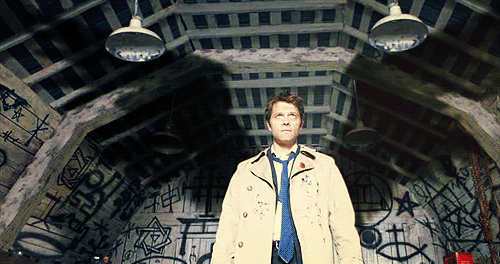
Obviously. I may be out of the fandom now, but I’ve never loved a character as much as Cas, and probably never will.
2. Good Omens. Aziraphale.

Thought I’d put both my darling angels at the top :) I suspect that without Zira there to pave the way Castiel may not even have existed, so I love him double - for himself and for Cas as well :p
While really quite different when it comes to their personalities (just think how Zira would SHUDDER at Cas’ trenchcoat), they share a lot of character traits and tropes (mini-series!Zira anyway, maybe less so in the book, or less obviously anyway), so, no surprise that I should adore them both. I’ve also said before, and I stand by it, that Aziraphale is sort of a combination of my favourite aspects of both Cas and Dean in one, with Cas’ struggle with Heaven/god and trying to be a good angel and finding he loves humanity/earth more, plus Dean’s whole ‘performing Dean’ thing and repression of queer feelings he is scared to admit to (out loud) because he believes they are somehow ‘wrong.’
...just to give a little insight into my feelings about these two that was neither needed nor asked for...
4. Hellblazer. NBC Constantine. Legends of Tomorrow. John Constantine.

Aaaand the other guy I love twice because Cas, and indeed spn in general, kinda owe their existence to him. Though in turn his fabulous live action portrayal by Matt Ryan probably owes its existence to spn and Castiel’s popularity. So... there’s a weird ouroboros situation happening with my favs here that makes my head spin whenever I think about it, but I love it - stories within stories built on stories feeding off stories, which connects to wider themes of story and storytelling being vital and intrinsic to life and stuff.
Anyway, despite his wardrobe, Johnny is NOTHING LIKE CAS. He is, in fact, a lot like Dean. But I like him more. Maybe because he’s British :p He has the whole ‘repressing his feelings’ things, a bit like Zira, but it’s not because he thinks they are wrong, it’s more of a coping mechanism to deal with the constant tragedy/trauma his life/lifestyle/fate causes him to suffer. But whatever the reason, I like my characters facing that struggle :) (actually the British element is probably way more significant to my enjoyment of him than I’ve been fully aware of... that’s probably why I loved Zira so fast as well... obviously they are both a completely different class of British, literally, but the fact they ARE British is INTRINSIC to both their characters, and I guess a little, vaguely patriotic part of me is excited by that... :p)
4. Gotham. Edward Nygma.
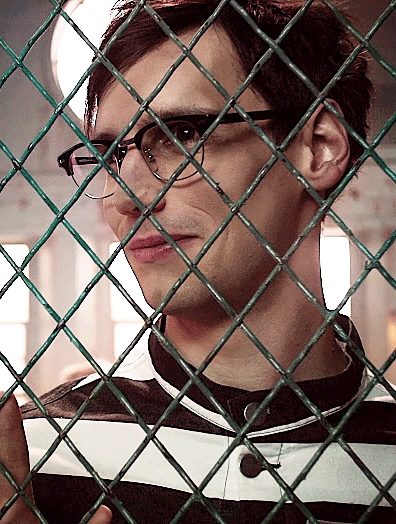
Since I’ve started giving explanations - I love Eddie because he’s also got the whole ‘emotionally repressed’ / out of touch with (his) emotions thing going on (as seen in Zira and Cas), but with the addition of various geeky / ‘tech guy’ character traits that I also love.
5. Doctor Who (Classic). Vislor Turlough.
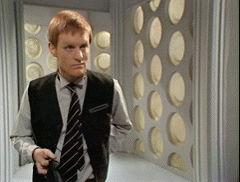
I waxed poetic once about how I liked Gotham’s Edward Nygma because he reminded me a bit of Turlough. That was early on in my Gotham days though and given how Eddie developed I don’t see as many similarities now. Turlough shares some of Eddie’s ‘dark’ traits however - self-centered, often lacking in empathy for others and nonplussed (sometimes even happy) to see them get into trouble or hurt. But ultimately his attempts to be self-serving and cowardly end up thwarted by him developing feelings for specific individuals despite his best efforts, which is what I enjoy about him (and actually that’s a lot like Eddie still, huh... their endgame’s are opposing though ofc - while Eddie goes on to embrace being a villain, Turlough gives up on villainy and even becomes a bit of a hero, now and then). Plus, Turlough is the ONLY Companion (IIRC?) to have joined the Doctor specifically in order to MURDER him and... idk, I just think that’s cool :P
6. Doctor Who (New). Donna Noble.
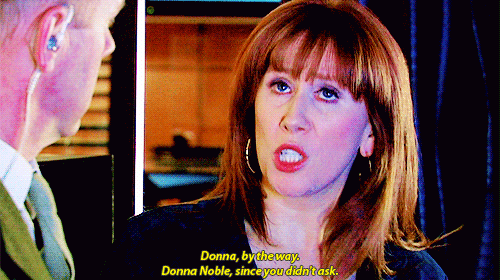
(I’m trying not to double up on fandoms/shows so I can cover more, but New and Classic Who count as different things, kinda, right...?)
Donna doesn’t really fit any of the character traits I’ve talked about above, though I guess her low self-esteem is something that all my other favs share in various ways (though it’s not such an EXPLICIT aspect of their characters and story arcs as it was for Donna I’d say). What I first loved about her was that after YEARS of New companions (and other randoms) being literally in love with the Doctor, she had a strictly platonic relationship with him. Yeah, I think maybe the show was a bit heavy-handed about it, but even so it came as a huge breath of fresh air and frankly a RELIEF to me. Not that I’m opposed to the Doctor having romantic/sexual relationships, it was just that... coming from a childhood love of the Classic series where that just... didn’t happen (save a fleeting kiss in the TV Movie - which I actually enjoyed fyi!), it just... idk, was starting to stretch my credulity that EVERYONE seemed to be falling for him maybe? Or at least for me it was growing tiresome. So the fact she didn’t have that element to her character/story was a plus. Then I just adore how loud and brash she is when calling anyone, including the Doctor, out on their shit (I envy her that maybe). Plus I like the way she isn’t... traditional TV pretty, you know? (ie. young and slim, like a lot of other companions).
...or maybe I just like redheads *shrug emoji*
7. Spartacus. Naevia.
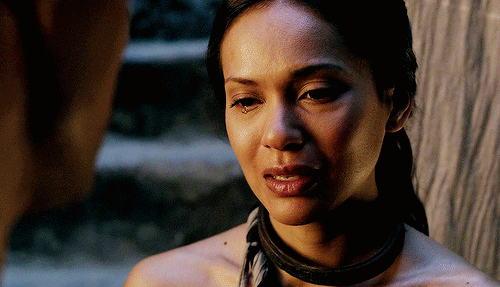

(she has two actresses okay? and they both deserve kudos!)
Truth is I love FUCKING EVERYTHING AND EVERYONE IN THIS SHOW. Spartacus is like... my PERFECT SHOW. There isn’t a single moment, a single plotline, a single character that I don’t enjoy. I have never even CONSIDERED looking up or writing fic because the finished product is completely satisfying exactly as it is. God. But I wanted it represented in this list so I had to pick someone!
Considering the time period there couldn’t really BE a ‘geeky, emotionally repressed with low self-esteem’ character :p BUT nearly ALL of the characters have the whole ‘struggle to understand/discover who they are’ thing and the ‘who I am and want to be is counter to who I’ve been told I am / should be’ arc, on account of the main cast being rebelling slaves (though the other characters are equally complex and compelling and I love them too - Lucy Lawless in particular is incredible!). Anyone who’s seen me blog about the show before might have thought I’d pick either Agron or Nasir as my favs, since I do like to squee over their romance. But whenever I think about the show it’s usually Naevia who I remember first, because her character arc/development just BLEW ME AWAY. She went from someone I’d kinda dismissed at first as a typical het love interest to a WARRIOR GODDESS and you SEE all the key moments of that growth, you FEEL it, it makes ALL THE SENSE. And her romance with Crixus, which again I was initially a bit dismissive of as a typical, sudden, weak het romance, grows into, imo, one of the deepest, most developed, most believable love stories in the show. So yeah. Naevia. Amazing.
8. Due South. Ray Vecchio.

(he’s the guy not the dog - gifs were limited! ...also the dog is actually a wolf, it’s a whole thing... that doesn’t need exploring at this juncture)
Ray was my first TV crush :P He had a bit of a sidekick vibe to him I guess, which I like (lead characters tend not to interest me as much). He wasn’t ‘geeky’ exactly, but he def had the ‘trying to look/act cooler than I am’ thing going on... also an obsessive attachment to his vintage car... meanwhile his partner Benny was the stoic, ‘British, stiff upper lip, keep emotions in check’ one who was always trying to live up to the ideal persona dictated by his people/employers, in this case the Royal Canadian Mounted Police... HUH, so... it’s actually SUPER WEIRD that I ended up loving Cas and Zira over Dean and Crowley when it seems pretty clear suddenly that my first big fictional fav was CLEARLY the Dean-Crowley to Benny’s Cas-Zira......?? Ray was FUNNY in a way Dean and Crowley aren’t though, I think? He def filled a ‘comic relief’ slot on the regular and I liked that a lot (it also made his serious, angsty moments EXTRA serious and angsty, and extra angst is something I always love!)
9. The Librarians. Eve Baird.

Remember this little show? It was... is... sorta ridiculous. Not amazing. Based on some... very cheap, very OBVIOUS Indiana Jones rip-off films, that were also ridiculous and... not... great (the third one is the best, with an awesome performance by Stana Katic aka Kate Beckett as a vampire, but I digress). But... idek, I am EXTREMELY FOND of the series for some reason :p
There are a WHOLE BUNCH of characters that fit my ‘type’ more than Eve tbh... in fact... probably every.single.other.main.cast.member (save perhaps Jenkins?) shares the traits above that typically make a character my fav. But... EVE! I just... think she’s neat! ...maybe it’s BECAUSE all the others are main/lead characters that makes me gravitate towards her? In a cast where ‘geeky, socially awkward, struggles with emotions’ is the norm, Eve being the no-nonsense, socially competent, badass soldier type therefore becomes different and thus more interesting to me? Also, much like with Donna, I appreciate that she’s an older woman who gets to have a full character and plot of her own. There’s also something about her romance with Flynn that... makes me feel warm and fuzzy.
10. Buffy the Vampire Slayer. Jonathan Levinson.

(tumblr gif search failed me so I had to grab from elsewhere...)
Listen. Look. Okay. Buffy is pretty old school these days so, for anyone not in the know, as a character, originally, Jonathan... he wasn’t even a side character, he wasn’t even REOCCURRING, he was barely a background character. For several episodes he didn’t have a name and it wasn’t until several seasons after he became ‘Jonathan’ that he actually got a surname. Danny Strong was just an actor who happened to be occasionally on-hand when the script called for a random to have a line, until eventually that happened often enough for Joss to think ‘hey, you know what, let’s make this guy an actual part of the show...’
He got a couple of episodes focused on him in S03 and S04 respectively, but didn’t become a regular until S06 (and wasn’t in S05 AT ALL). Other than that he had a HANDFUL of ‘blink and you’ll miss it’ moments here and there, not even full scenes for the most part, usually lasting no longer than the above gif.
I tell you all this so that when I say childhood me (well... somewhere between 12 and 14 years anyway) was OBSESSED with this character in the show, and I mean O B S E S S E D (to the point of spending hours painstakingly making VHS recordings purely of the episodes he was in), you understand how UTTERLY BIZARRE that was. Because this obsession pre-dated S06. Was, in fact, in full swing during the airing of his S04 episode - which was, like, a fucking DREAM COME TRUE for freakily obsessed me fyi, because the whole episode was constructed with him as the LEAD CHARACTER, because he’d performed a spell to make him super awesome. They even changed the title sequence to read ‘Jonathan’ instead of Buffy! And while other fans were no doubt just lol-ing at the random I was bouncing about on my sofa all ‘MY TIME HAS COME!’ and fucking SWOONING over seeing MY CHARACTER suddenly in the spotlight and getting to do crazy fun OOC shit like this -
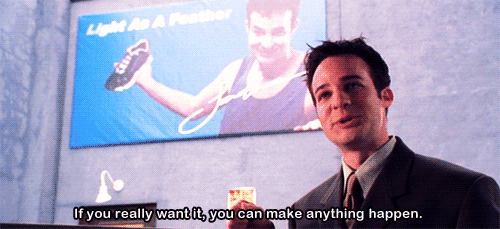
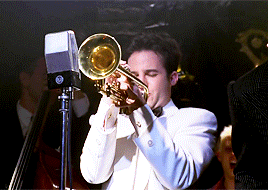
Then when S06 rolled around and HE WAS A LEGIT REGULAR, omg, I was in HEAVEN! First TV boxset I ever bought that - Buffy S06 :P
So... yeah. A bit of a fav. Geeky. Outcast. Slowly grows more morally grey, what with that spell I mentioned and also the fact he was teamed with the ANTAGONISTS in S06. I guess you could say he was the beginning of a lot of my fav fictional character traits/tropes (though looking back - I think his ‘villainous’ teammates in S06, Andrew and Warren, are more my ‘type’ these days, and I did end up loving Andrew especially a whole damn lot, but at the time I’d been a Jonathan fangirl for so.fucking.long. there was just no chance anyone else in the show was ever gonna come close to my heart!)
THE END.
Sorry not sorry for the tmi. I got a bit too into this one.
Actually sorry I have so few women on the list :( Internalised misogyny/sexism is a real thing and I spent a lot of my life being... somewhat unfairly dismissive of female characters or at least prioritising male ones over them. I’m working on it.
Ten people is SO.MANY. to tag. But I might as well do this right this time, since I’ve come so far. But if you’d rather not play, no worries! <3
@enchantersnight @momecat @bold-sartorial-statement @vampirebillionaire @edwardnashtons @miss-olivia-cellophane @knightinpinkunderwear @supes9 @leaper182 @hamburgergod
Honourable mentions (because I CAN):
Gotham. Lucius Fox.

Gotham. Fish Mooney.

Gotham. Tabitha Galavan.
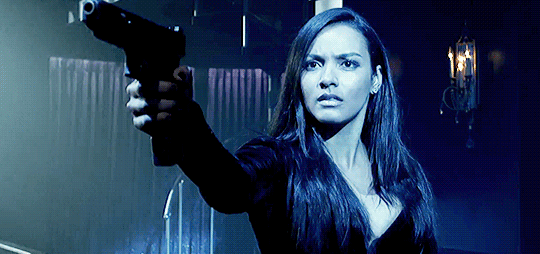
Doctor Who. The Doctor.
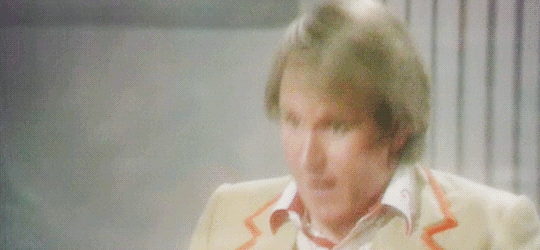


Doctor Who. The Master/Missy.

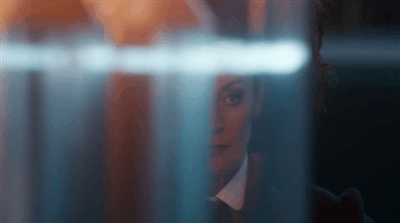
Supernatural. Hannah.

Supernatural. Naomi.
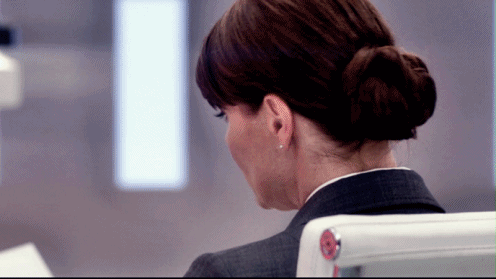
Buffy the Vampire Slayer. Andrew Wells.
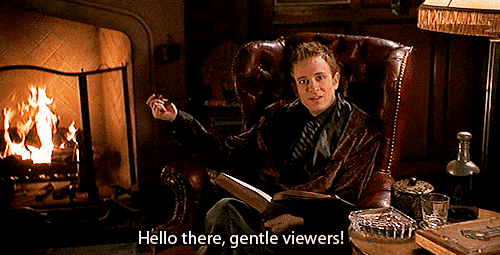
#about me#a true but boring story#well this was a fun nostalgia fest for me!#apologies to the rest of you.............
16 notes
·
View notes
Text
The Peculiar History Of The Sect Known As The Quakers (Bristol radical Pamphleteers) Pamphlet – 2011-by Jim McNeill
..yet my mind was not at rest, because nothing was acted, and thoughts run in me that words and writings were all nothing, and must die, for action is the life of all, and if thou dost not act, thou dost nothing,"
Gerrards Winstanley
Where is the good old cause now?...and what is become of it? In whose hands does it lie?
Edward Burrough, To the Whole English Army(1659)
Friends, Meddle Not with the Powers of the Earth,
George Fox
Despite being only sixteen pages long, The Peculiar History Of The Sect Known as the Quakers poses a number of questions, who were the Quakers? Why were they persecuted? Why did they stop being radical? How did some of Bristol's Quakers become so rich?
Jim McNeill’s excellent pamphlet give partial answers to the above questions and encourages the reader to read around the subject. Even a cursory look at the early history of the Quakers tell us that they were a mass of contradictions. During the English Revolution, the Quakers were closely aligned with other radical groups such as the Levellers and Diggers.
As Alan Cole explains “for nearly thirty years after the defeat of the Levellers at Burford, no political party emerged which could claim the effective support of the English radicals. Throughout this period the main centres of resistance were the Puritan sects and the history of the radical movement of the time, therefore, is closely bound up with the history of religious dissent. It is this fact which lends peculiar interest to the history of the early Quakers. For the rise of the Quakers spans the period from the breach between Cromwell and the radical movement to the emergence of the new Country Party at the end of the 1670's; and conversely, the decline of Quakerism in England may be traced back to the final defeat of the popular movement and the political compromise of 1688. Moreover, the first Quakers had had close connections with the earlier radical movement. Like the Levellers, most of them came from the class of petty traders and handicraftsmen, although it is worth noting that the movement made more headway among the peasantry than the Levellers had done. Over half the early Quaker leaders were directly connected with the land, and throughout the century the movement remained strong in the rural districts of the north and west”[1].
McNeil is one of only a handful of left-wing historians who have examined the Quakers in the context of their role in the English revolution. Christopher Hill’s output on the Quakers was reduced amounted to a lecture at Friend’s House in London in 1993 and his book The World Turned Upside Down he devoted one chapter which included the Ranters alongside the Quakers. This is not down to a lack of resources. Hill’s limited work on the Quakers contained very little original research.
In many ways, the Quakers are the forgotten radicals of the English revolution. As Jean Hatton[2] points out in her excellent biography, the Quaker leader George Fox is hardly known outside the Quaker movement. If ever a person needed rescuing from the condescension of history, Fox is it.
Mcneill poses an interesting question in his pamphlet? How did an early movement that expressed egalitarian strivings of the more poorer sections of society end up playing such a crucial role in the early development of capitalism? As McNeill points, it was Quakers that founded most of the big banks that now operate like colossus over the world.One answer not really explored by McNeill lies in the class nature of the Quakers. While containing some plebian elements, this was essentially a movement in modern terms of what would be the lower middle class. If truth be told, it was mainly the plebian elements that gave the movement its radical edge.
As McNeill points out the early Quaker movement exploded during the English revolution alongside side other radical groups, Seekers, Ranters, Antinomians, Seventh Day Baptists, Soul sleepers, Adamites, Diggers, Levellers, Anabaptists, Mennonites, Behmenists, Muggletonians to name but a few.
In Christopher Hill's The World Turned Upside Down[3] he explains the reasoning behind this explosion of radicalism and a world that was turned upside down, Hill writes:
“From, say, 1645 to 1653, there was a great overturning, questioning, revaluing, of everything in England. Old institutions, old beliefs, old values came in question. Men moved easily from one critical group to another, and a Quaker of the early 1650s had far more in common with a Leveller, a Digger, or a Ranter than with a modern member of the Society of Friends”.
It is interesting that Hill’s in the book puts the Quakers with the Ranters in his only stand-alone chapter in the book. As Hill points out that Ranters were often confused with Ranters. George Fox leader of the Quakers would spend a large amount of his time trying to distance his movement away from the Ranters.
In 1652 Quakerism was at the height of its power, but from then onwards its radicalism started to wane very badly. As Hill explains the ebbing of the Quaker movement "In time of defeat when the wave of revolution was ebbing, the inner voice became quietist, pacifist. This voice only was recognized by others as God's. God was no longer served by the extravagant gesture, whether Nayler's entry into Bristol or the blasphemy of the Ranters. Once the group decided this way, all the pressures were in the direction of accepting modes of expression not too shocking to the society in which men had to live and earn their living. The radicals were so effectively silenced that we do not know whether many held out in isolation with Milton. We do not even know about Winstanley. But what looked in the Ranter heyday as though it might become a counter-culture became a corner of the bourgeois culture whose occupants asked only to be left alone."
It is no coincidence that its move away from its early radicalism coincided with the rise of capitalism which it played an extremely important part. During the early part of the 18th century and 9th century, Quakers went on to be an indispensable tool in the development of capitalism.
They were especially important in the field of technological innovations. Industrial capitalism would rely heavily on Quaker's inventions. As Steven Davison points out “They build many of the key industries, establish many of the most important companies, build its financial infrastructure, develop new modes of organization, and pioneer humane treatment of workers. At the same time that they are engaging the world of business, industry and commerce with incredible energy and invention, they are withdrawing from engagement with the world in virtually every other area of life. Friends maintain this double culture for two hundred years. In England, they become fabulously wealthy; in America, they do pretty well[4].
[1] The Quakers and the English Revolution: Alan Cole -Past & Present, No. 10 (Nov., 1956), pp. 39-54
[2] George Fox: A Biography of the Founder of the Quakers Paperback – 1 Sep 2007-by Jean Hatton
[3] The World Turned Upside Down: Radical Ideas During the English Revolution (Penguin History) Paperback – 12 Dec 1991
[4] Quakers & Capitalism: A Brief Recap- https://throughtheflamingsword.wordpress.com/2011/09/09/quakers-capitalism-a-brief-recap/
1 note
·
View note
Text
Blog Post:

A significant shift in the air tells us that the big, bold and the beautiful has arrived at our doorstep once again. As we prepare to welcome majestic covers and fresh beginnings, come the new season, excitement is an understatement for the fashion community when it comes to describing the annual presence of September. The anticipation of the coming season has inspired us to reflect upon an array of iconic September issues, both old and new, retelling and reflecting on their own individual, remarkable stories.
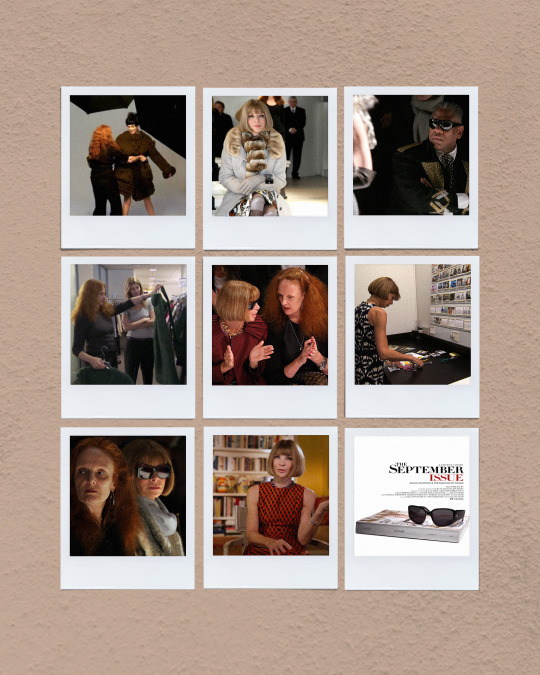
A quick throwback to 2009 and we arrive at popular fashion documentary The September Issue, staring some of the industries biggest giants including Anna Wintour and Grace Coddington. Together the duo welcomed us into American Vogue for an insightful look into the magazine’s biggest and most influential issue. Whilst fashion editor’s a like come under a monthly pressure of curating a magazine that harnesses both intriguing content and spectacular editorials, the issue with the strongest fashion pull continues to fall upon the month of September. But why is this? As the summer holidays conclude and there’s a back to school feeling looming, the significance of the Autumn/Winter season derives from it’s ‘fresh start’ appeal and, of course, the excitement of shopping for a new wardrobe. Out with the old and in with the new doesn’t go unnoticed, as the September continues to be the largest issue of the year due to the influx of advertisers, all keen to show off their new campaigns and collections.

Just five days ago Editor-In-Chief at British Vogue, Edward Enninful, revealed his September “Forces for Change” cover in collaboration with, and guest edited, by HRH The Duchess of Sussex. The beautiful cover uniquely welcomes 15 change-makers, “All titans in their respected fields” Edward praised on is Instagram post. If we remember back to the editor’s first issue of Vogue in December 2017, where the stunning Adwoa Aboah graced the cover, I find myself reliving that same urgency to get my hands on my own copy. Wanting a piece of the excitement just for myself. Edward has done just that once again, whilst he’s served us the magnificent in the meantime, it’s covers like this that are truly inspiring as we watch an iconic moment in fashion unfold in front of our very own eyes. From 16 year old climate and environmental activist Greta Thunberg, to 81 year old acting legend Jane Fonda. British Vogue certainly welcomes both the old and the new when celebrating extraordinary women that are redefining our world for the better. The most touching and perhaps most remarkable element to the cover falls responsible to the 16th slot, you. The Duchess herself specifically curated a space for me and you, allowing us to take our place alongside 15 other strong women. Simply by looking in the mirror, to be printed on the cover, we are all invited to be a part of this movement.

September 2018 in particular was an outlet for fashion magic, or more specifically #BlackGirlMagic. The trending hashtag was a result of an influx of beautiful Black women gracing the covers of some of the industries biggest publications, including Vogue, Porter and Elle. In the wake of this significant representation for women of colour, cover stars including Rihanna, Zendaya and Lupita Nyong’o were just a few of the talented women, of all different hues, showcasing the multifaceted beauty of Black women. These covers not only aided redefining the beauty standards within Western culture, but it also became a platform for showcasing both Black culture and talent through both the cover stars and the behind the scenes teams too. As Beyoncé’s starred on the US Vogue cover, for the fourth time, the singer hand-selected 23-year-old photographer Tyler Mitchell. This put Tyler amongst one of the youngest photographers to have shot the cover of Vogue, as well as the first African American to capture the cover in its 125 years of history. Never has a season seen so much diversity in its casting across a vast variety of publications, and once again, it truly was magical.
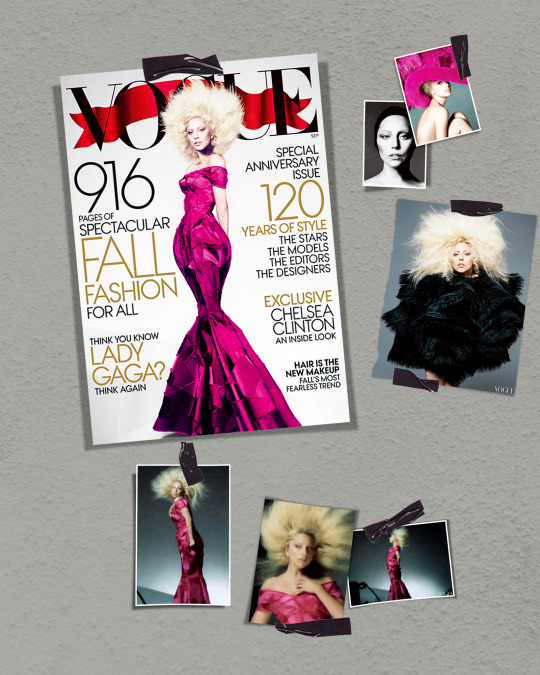
Perhaps it was down to a friend loaning me this magazine after his holiday in New York that has lead to me titling this 2012 cover as ‘iconic’. The striking fuchsia of the Marc Jacobs gown brings me back to almost a child-like state of mind, when the fashion industry seemed so foreign and holding a glossy magazine from New York was the pinnacle point of my week, perhaps month. Yet, from her eyebrow raising decision to leak the cover on her fanbase website, Little Monsters, Gaga aligned her appearance with US Vogue as both exciting and controversial from the outset. Seemingly without blessing from the publications Editor-In-Chief, Anna Wintour, the singer wrote “SHH DONT TELL TWITTER/ SEPT ISSUE OF VOGUE MAGAZINE/ Sorry Anna but the underground kids deserve it.” Following this, although no secret fashion editorials are all subjected to retouching, more press amounted as the magazine innocently released a behind the scenes video unaware that they were also blowing their cover. Literally. The stark contrast revealed the not so fabulous Marc Jacobs gown was no where near as flattering or ‘cinching’ and her bleached mane was no more than a birds nest. Leaving the cover as a bittersweet moment for as the ‘Born this Way’ singer as she appeared to not be practicing what she preached.
As publications begin releasing their covers and they hit newsstands in the coming days, LOVE, Cosmopolitan and Harper’s Bazaar, to name a few, will appear to be left in the shadow of magazine giant British Vogue, as they continue to steal the headlines. Astonishingly perhaps a magazine will become the ‘must-have’ item this season and a Gucci handbag won’t be comparable to the originality crafted by HRH Duchess of Sussex, Edward Enninful and the 15 change-makers.
Discussing the Autumn/Winter seasons has us excited to share with you our A/W19 collection, follow us on all social media platforms for upcoming sneak-peaks to be revealed soon!
https://mellaris.com/
#mellaris#mellarisofficial#fashion#fashionbrand#fashionblog#blog#readnow#vogue#septemberissue#aw19#summertime#ellemagazine#portermagazine#moda#mode#style#blogpost#fashionpost#voguemagazine#ukvogue#usvogue
4 notes
·
View notes